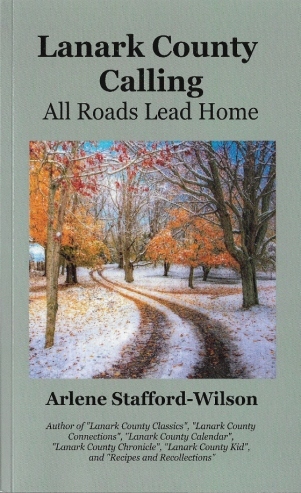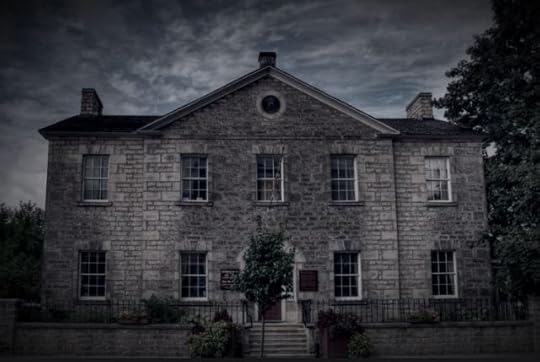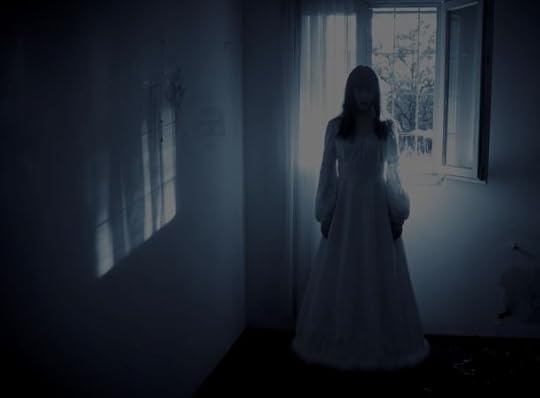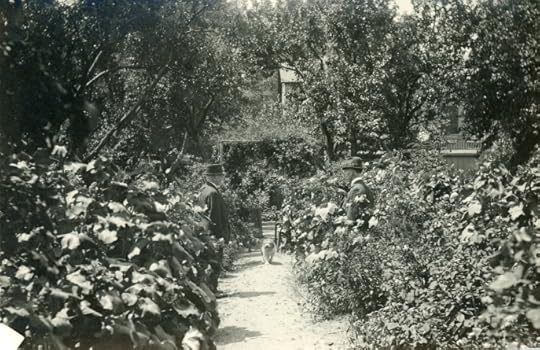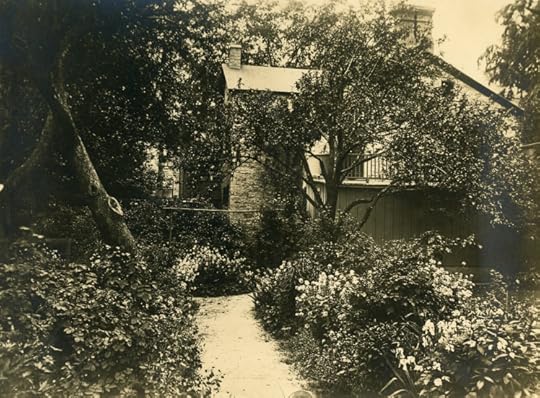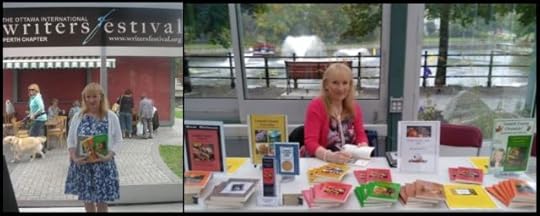Arlene Stafford-Wilson's Blog, page 26
October 18, 2022
Irish Wakes
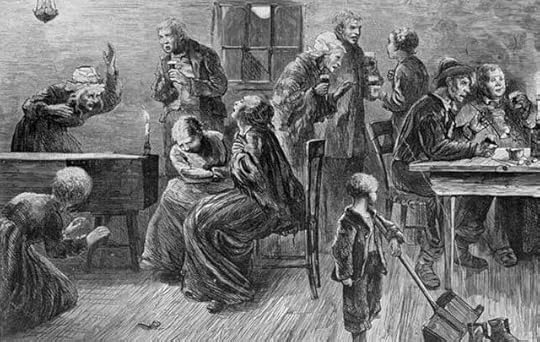 Depiction of an Irish wake – 1873
Depiction of an Irish wake – 1873Traditions of the Irish Wake
“The terrible thing about dying is
that you miss your own wake”
David Allen, Irish Comedian
Traditions seem to go on forever in small rural communities. They are passed down from father to son, and from mother to daughter. The tiny community of Ferguson Falls was settled by seven Irish bachelors and their story was told and re-told through the ages, so it wouldn’t be forgotten. When these young men landed from the old country in the early days they made a pledge to help each other to succeed in the new land, and if even one of them failed to thrive they would all return to Ireland. They were Patrick Quinn, John Quinn, James Carberry, William Scanlan, Terrence Doyle, John Cullen and James Power.
Around the same time my own ancestors arrived – the Stafford and the McGarry families, from County Wexford and County Westmeath, and the Irish-Catholic community grew and prospered in this idyllic community along the Mississippi River in Drummond Township.
In those days it was unusual and even frowned-upon to marry outside of one’s religion, and so the traditions and customs brought from the old country remained firmly entrenched in these early settlers and their families and were passed down for generations. It’s not surprising that many of these practices were still taking place in the 20th century, some with pagan Celtic origins, some more religious, and some so ancient they could no longer be explained.
As a young girl I heard stories, mostly from my father, who grew up near Ferguson Falls, and also some vivid tales from some of the old timers in the area. Some of their most colourful accounts included stories about their Irish wakes.
I remember my father telling me about his uncle’s wake, held in the family home, as was the custom. He said that the wakes were another excuse for people to get drunk, maybe a little drunker than usual, and they did some things that were almost unspeakable. He recalled his deceased relative being ‘laid out’ on the dining room table and that late at night two of the intoxicated guests attempted to pour whiskey down the dead man’s throat.
Many years ago, I also heard from one of the old-timers, James ‘Jim’ Quinn, a direct descendant of one of the seven Irish bachelors, that the standard rate to dig a grave was a bottle of whiskey. The usual amount was twenty-six ounces and was split between two men, who dug the graves by hand at St. Patrick’s cemetery. He was, in fact, according to him, one of the two who dug the grave for my great uncle Jimmy Richards, and the lads were paid in the usual way, a bottle of whiskey, from my great aunt Tessie Richards, the departed’s sister.
The ‘Third Birthday’
The eldest ones used to refer to death as ‘the third birthday’. They claimed that the first birthday was the day you were born, and the second birthday was your baptism. The third birthday is the day you pass away, and should be filled with both mourning and celebration as you move from this life and enter Heaven.
Stop the Clocks

All clocks in the house are stopped at the hour of the death as a sign that the passage of time has ended for the departed. Time stands still for them, and a new period of existence begins, without time. It was believed that if time continued to move ahead that this invited their spirit to remain in the home rather than moving on. Some say it was also a way to mark the time of death. Others claimed it is done so mourners will stay as long as they please without worrying about the time.
The Open Window
Immediately after the death, the window closest to the deceased is opened for two hours. The open window allows the spirit to leave the body. No one must stand near nor block the path to the window as it might prevent the spirit from leaving, and will bring misfortune to any person who blocks it. After two hours have passed the window is closed so that the spirit doesn’t attempt to re-enter the body.

Close the Curtains
With the exception of the open window closest to the deceased, all other windows are to be closed, and the curtains should be drawn until the body is removed from the home for burial. It was thought that if a moonbeam shone through a window at night that evil spirits could come in and try to steal the deceased’s soul.
Photographs Turned Face-Down
Family photographs were turned face-down so that the people in the pictures would not be spirited away with the deceased.
Cover the Mirrors
All of the mirrors in the home were either covered with cloths, or turned backward, facing the walls. There were two reasons behind this custom – that the deceased’s spirit doesn’t see their physical body in the mirror as they leave the home, and so that their spirit doesn’t get trapped inside the looking glass.
Mourning Cards
In the old days people kept black-bordered funeral stationary in their homes. Shortly after the death occurred, they wrote an announcement by hand, on a full sheet, enclosed it in black-bordered envelope and pinned the notice with a thumb-tack to the outside door. A black ribbon was also hung on the door. Neighbours could stop and read the announcement and learn of the date and times of the wake and funeral. A note at the bottom of the page encouraged neighbours to spread the news. A call was placed to local printers to order formal funeral cards, which included information about the deceased, and sometimes a photo or a prayer. The Mourning cards were also known as Prayer cards or Holy cards. Local newspapers were called and orders for obituaries were placed. The Mourning cards were available at the wake and at the funeral and given as a keepsake for the mourner to bring home with them.

Traditional Mourning stationery
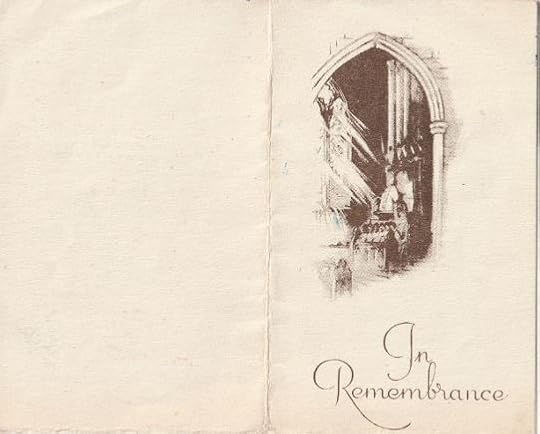
Mourning card – Anastasia ‘Stacy’ Richards Stafford (my grandmother) 1954
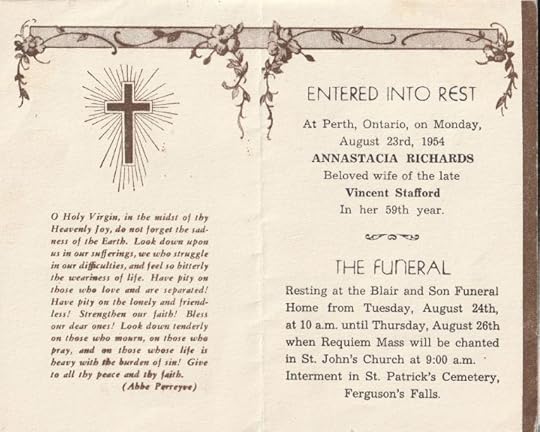
Anastasia ‘Stacy’ Richards Stafford – Mourning card – 1954
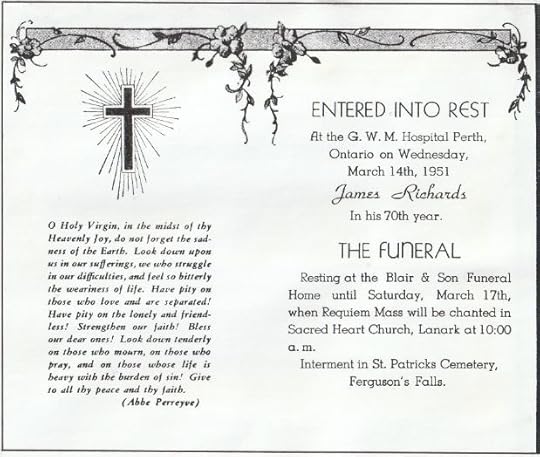
James ‘Jimmy’ Richards – Mourning card – 1951 (Jimmy, my great-uncle, was a farmer in Ferguson Falls and well-known local musician who regularly played his fiddle at the infamous Stumble Inn)
Preparation
The body of the deceased was washed with Holy water, and dressed in their best clothing. There were often older women in the community who performed this task for the families, and were offered whiskey or food as payment and thanks. Men were shaved and both men and women had their hair combed and arranged nicely. Conservative dress was expected for the deceased and bright or pastel colours were not considered appropriate. The bodies were laid out on top of white sheets, usually on a long flat surface, such a dining room table. In Catholic homes rosary beads would be wound around the hand, with the crucifix laying on the person’s chest, close to their hearts. Once the body was prepared the deceased was never left alone in the room. At least one person must remain, and usually there were groups of people who remained awake through the night with the dearly departed. This custom of remaining awake is the origin of the term ‘wake’.
Candles
In some families white candles were placed all around the table where the deceased was laid out, however some families used only 4 candles placed around each of the four corners of the table. Candles were to remain lit (replaced as needed) until the body left for the funeral. It was bad luck to let one of the candles burn out and they were replaced as they burned down close to the end of the wick. The candles used at wakes were said to have healing powers, and the butts of the used candles would be saved and rubbed on burns and cuts.

Keening
Keening comes from the Gaelic word meaning ‘to cry’. Women from the neighbourhood would gather at the wake and sob. There were even professional keeners who could be hired to cry at wakes. The art of keening originates from the Irish Banshees who shrieked and screamed foretelling a death. It’s been said that every family of Irish origin has their own Banshee, and that they even traveled with families across the ocean to the new world.
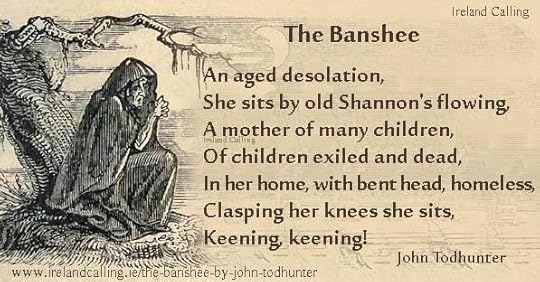
John Todhunter, Ireland Calling
What to Expect
If you’re planning to attend an Irish wake, then be sure to bring a little something for the family. Food, flowers or something to drink is always welcome, and a bottle of good spirits is always appreciated.
Although there is no dress code, wearing black or somber colours is a sign of respect to the family.
After a brief viewing of the deceased, you may pay your respects to the family with a few words, like: “Sorry for your troubles.”, or “Sorry for your loss.” It is a stressful time, and it’s not as important what you say, but more that you showed respect by attending.
The time you spend at the wake can be brief, as little as fifteen or twenty minutes, if you didn’t know the deceased very well. The busiest time will be the evenings, after suppertime, between 5 p.m. and 8 p.m. Neighbours, good friends and family members will remain at the wake for four to five hours, and the closest will stay all night, at least one night, in the room where the deceased is laid out.
The Food and Drink
After the wailing is over, the more social aspects of the wake begin. Food and drink for visitors are provided by the family, and it is customary for guests to bring a bottle of spirits, or some food for the wake. Shepherd’s Pie, Irish Stew, Corned Beef and Cabbage, cold cuts, and small sandwiches are common at wakes. Tea is served in fine china cups, and whiskey, beer, and wine are the most popular drinks, although any spirits will do.
Raise a Glass
It’s customary during the wake to raise your glass and toast the deceased. You might begin the toast by telling a little story about your friendship, or something amusing that happened, that the two of you shared. Some of the most popular Irish toasts at a wake: “May he rest in peace.”, “Gone, but not forgotten.”, “No one spread more love in a lifetime.”, “To absent friends.”, “To our friend who has gone on before us.”
The Smoking of the Pipe
A long-standing tradition is the custom of smoking from clay pipes. These small pipes were filled with tobacco for visitors to the wake house to take. Visitors lit the pipe and took a draw, exclaiming “Lord have mercy on their soul”. Non-smokers were also expected to partake of the ritual and in some cases snuff was also taken. After the funeral, the family broke the wake-pipes in two and buried them outside.
The Story-telling
It wouldn’t be a proper Irish wake without telling stories or reciting poems about the dearly departed. Fond memories are shared and become more animated and exaggerated as the whiskey flows throughout the days and evenings. There are stories of the school years from former classmates, and stories of the departed’s years of work, and about their profession. Family stories and memories are shared with guests, with highlights of a life well-lived, and special anecdotes of their days on the Earth. Fiddles and flutes are played and songs are sung, jigs are danced, and stories continue throughout the days and evenings.
At midnight, the Rosary is said, concluding with: “Pray for us now, and at the hour of our death.” The neighbours, friends, and other guests leave the home, with only those closest to the departed remaining.
Some family members and dearest friends will stay all night in the room with the deceased. The stories and the drinking will continue overnight, and a new group will relieve them in the morning so they can get some rest. It is usual to wake for two to three nights before the funeral.
The Funeral
On the third day of the wake, the body is placed in a coffin and carried out of the home, always feet first, in order to prevent the spirit from looking back and beckoning another member of the family to join them.
Once the departed has been carried from the home, the mirrors are uncovered, the curtains pulled back, and the photographs are displayed again.
Exactly six pallbearers carry the coffin, and there should be 6 handles on the casket, three on each side, in remembrance of the Holy Trinity: Father, Son, and Holy Ghost. It isn’t always the case these days, but that is the Irish tradition. It is also thought to be bad luck to go home the same route as the one used by the funeral procession.
The funeral is usually held in church, and after that everyone proceeds to the cemetery. A short graveside service will be conducted by the priest.
Rain is a Blessing

Rain the day of the funeral is a sign of a blessing, and if you hear a thunder-clap it means that the deceased has arrived in heaven.
After the funeral, everyone will be invited back to the house, to a bar, or community location for some food and drinks to toast to the deceased and honour their memory together for one last time.
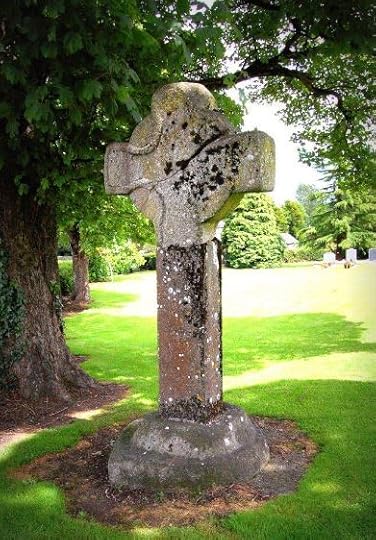
Many of the traditions of the Irish wake live on today, depending on where you live. Some customs have been adapted for modern times, and some of the old ways passed down through families, are strictly followed, as they were in days gone by.
“Grant them eternal rest, O Lord,
and may the souls of the faithful departed,
through the mercy of God, rest in peace.
Amen.”

St. Patrick’s Church, Ferguson Falls, Ontario, Canada, est. 1856.
“But since it fell into my lot
That I should rise and you should not
I’ll gently rise and softly call
Good night and joy be to you all
So fill to me the parting glass
And drink a health whate’er befalls
Then gently rise and softly call
Good night and joy be to you all.”
“The Parting Glass”, written by Trad / David Anthony Downes
Sources for “Irish Wakes”
Delaney, Mary Murray. Of Irish Ways. Dillon Press, Inc, 1973
Staffords Funerals, website, Dublin, Ireland
Bourke.A (1988), The Irish Lament and the Grieving Process, Women’s Studies International Forum, Vol.11, No.4
Danaher.K (1962), In Ireland Long Ago, Mercier Press.
Lysaght.P (1988), Caoineadh os Cionn Coirp: The Lament for the Dead in Ireland, Folklore 108.
About the Author:
Arlene Stafford-Wilson was raised on a small farm in Bathurst (Tay Valley) Township. Her Stafford and McGarry ancestors left southern Ireland, and arrived in Lanark County in 1816. She also descends from the McKittrick, Waters, Doyle, Carroll, and O’Keefe families, also from southern Ireland.
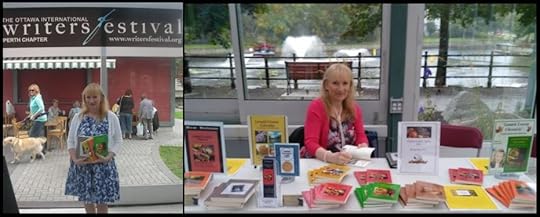 Arlene Stafford-Wilson
Arlene Stafford-Wilson

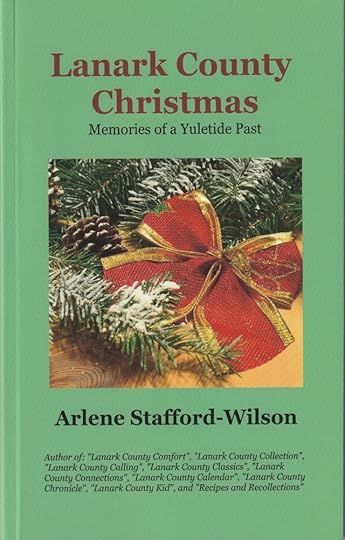
October 17, 2022
Elmcroft Mansion, Smiths Falls
Elmcroft was built in 1895, by Senator Francis Theodore Frost, President of the Frost & Wood company, manufacturers of farm implements. His father, Ebenezer Frost, founder of the company, settled in Smiths Falls in 1839 and opened a shop known as the Agricultural and Implement Works. Later, they began manufacturing stoves and plows, and grew into one of the most successful agricultural manufacturing companies in Canada.

Elmcroft – photo: William James Topley – family photo album – taken between 1890-1910
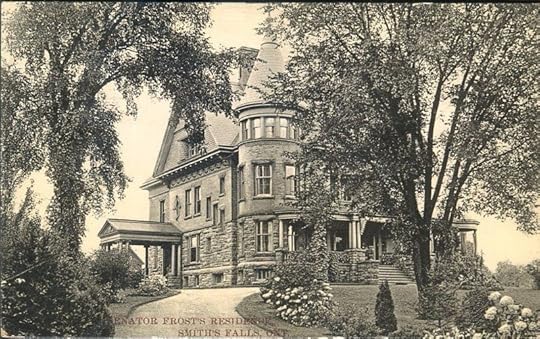
Elmcroft, 1907, photo: private family collection

The beautiful Maria Powell Frost, wife of Senator Frost, – photo: taken in Ottawa, 1873
Maria Eliza Powell Frost was born in Madrid, St. Lawrence County, New York, married Francis Theodore Frost on June 3rd, 1868.

Photo: Maria Frost in her later years. Maria was known for her service to the church and her support for local charities. For many years she taught the primary class of the Sunday School at St. Paul’s Presbyterian Church. She was elected to the National Council of Women of Canada and held that position for many years. She also represented the Smiths Falls Chapter at the Quinquennial Congress of the International Council of Women held in Toronto, Ontario, in 1909.
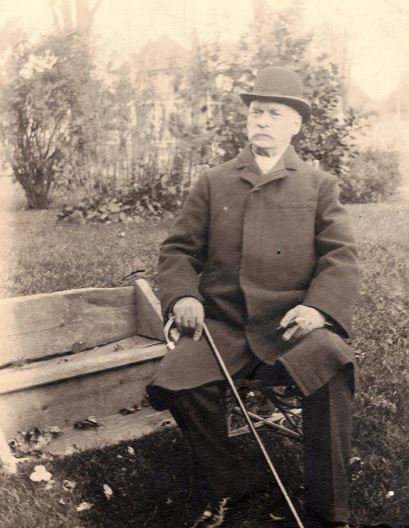
1915 Senator Frost sitting at Elmcroft Mansion, photo: JJ Kerfoot family album

Executives of Frost & Wood on the lawn in front of Senator Francis Frost’s home “Elmcroft”. Charles Frost, President, is seated on the far left. c. 1907
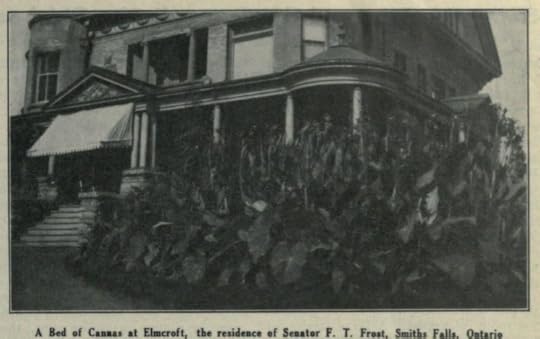
Elmcroft, featured in the March, 1911 edition of The Canadian Horticulturalist, highlighting its 27 ft x 15 ft Canna flower beds
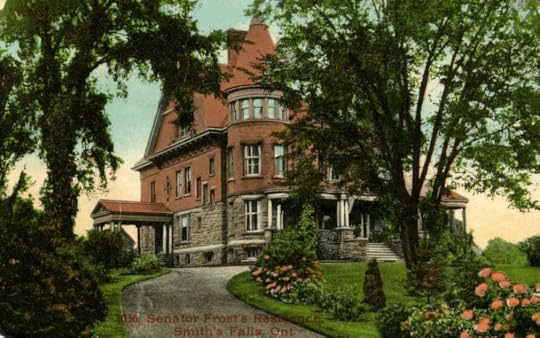 Elmcroft – Senator Frost’s Home, Smiths Falls, Ontario
Elmcroft – Senator Frost’s Home, Smiths Falls, OntarioIn 1901, Senator Francis Frost, 57, and his wife Maria, 54, lived at Elmcroft, along with Maria’s mother, Mary Powell, 84, and their two servants, Elizabeth Nolan and Mary Dillon, both age 28.

Sir Wilfred Laurier, the Prime Minister who appointed Francis T. Frost to the Senate, visited Elmcroft to enjoy tea with the Frost family
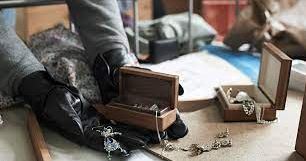
In July of 1907 a jewel thief entered Elmcroft and stole all of the Frost family’s opulent jewelry. The value of the jewels was so significant that the story of the burglary was featured in the Toronto Globe newspaper.
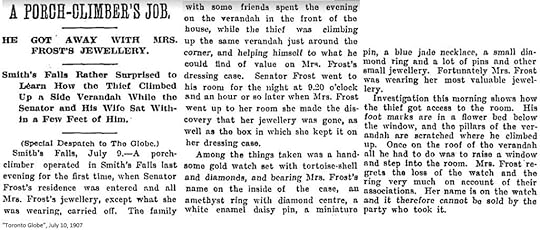
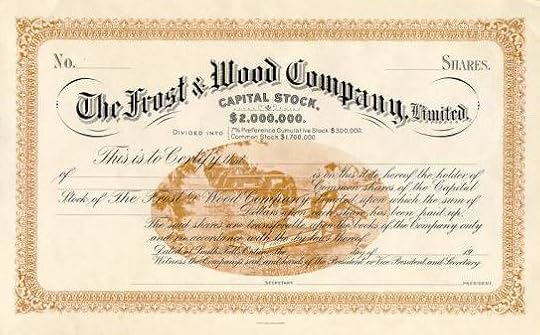
A share certificate from the Frost & Wood Company

The Frost & Wood company as it appeared in 1924
ELMCROFT TODAY
Elmcroft B & B
In 2008 Ken and Cathy Thom purchased the home known as Elmcroft, at 89 Chambers St., for $200,000. and after two years of extensive renovations, they opened the Elmcroft B & B in April of 2010.

photo: Tonia Kelly, Smiths Falls This Week, Metroland Media, March 31, 2011

The Smiths Falls Municipal Heritage Committee recommends that four mansions — all located on Chambers Street East — be designated as “Heritage Properties of Interest.”
The Frost Mansion Row includes:
Charles B. Frost Mansion
57 Chambers St. E.

Charles Beriah Frost, Vice-President of Frost & Wood Co.- (1840-1909)
(the property at 57 Chambers St. is already designated a Heritage Property of Interest. It has been divided into 11 separate apartments)
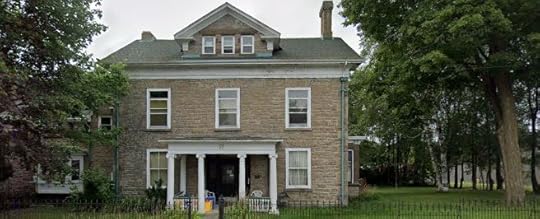
57 Chambers St. E.
The grand house at 57 Chambers St. E. was originally built for Abel Russell Ward who is considered the founder of Smiths Falls. His house was the largest and finest in the village at the time it was built. Abel Russell Ward owned the property until 1881 when it was sold to Charles B. Frost, and it remained in the Frost family for many years. It was designated a Heritage Property in 1983.
Edwin Frost Mansion
65 Chambers St. E.

65 Chambers St. E. – built in 1905 for Edwin Frost, currently owned by Joseph Murray
Edwin James Frost (1863-1921), son of James Trussell Frost and Jeannette Stinson Frost, Treasurer of Frost & Wood, married Laura Osborne Meighen (1873-1920). They had no children. The house, built in 1900, passed to Laura’s sister and her husband. This home has been divided into 7 apartments, owned by Joe Murray.
McKimm Mansion
69 Chambers St. E.
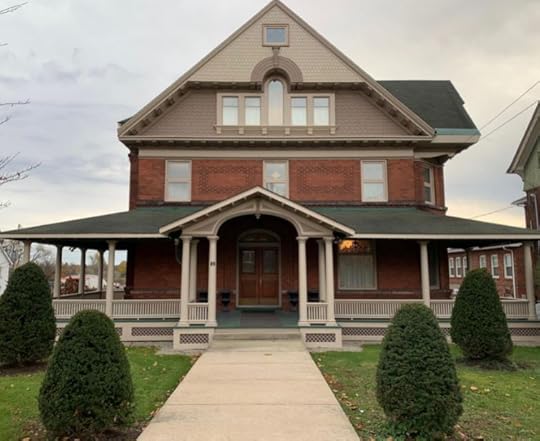
69 Chambers St. E. – photo: courtesy of Douglas McEwen, Nov. 2021
 69 Chambers St. E., side view, photo: courtesy of Douglas McEwen, Nov. 2021
69 Chambers St. E., side view, photo: courtesy of Douglas McEwen, Nov. 202169 Chambers St. E. was built in 1895, home of George Frederick McKimm. McKimm married Helen Elvira ‘Nellie’ Frost, daughter of James Trussell Frost and Jeannette Stinson Frost. George was Founder and Editor of “The Rideau Record”. The local newspaper, established in 1887, played an important role in local politics, and later became “The Record News”. McKimm played a pivotal role in securing funding from philanthropist, Andrew Carnegie, in 1902, to build the Smiths Falls Public Library.
Senator Frost’s Mansion
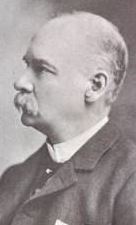
Senator Francis ‘Frank’ Theodore Frost (1843-1916)
89 Chambers St. E.
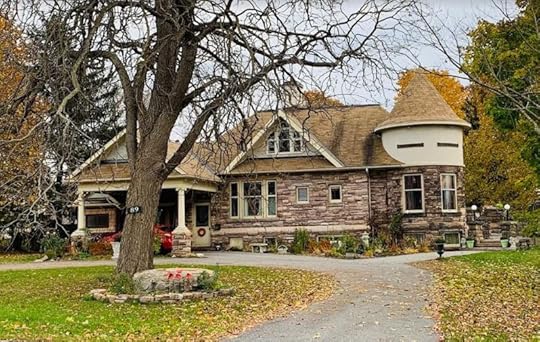
89 Chambers St. E., photo: courtesy of Douglas McEwen
Elmcroft Mansion Timeline
Senator Frost’s Mansion was originally built in 1895 as a three-storey mansion in the Queen Anne revival style. Senator Francis T. Frost, the son of the founder Ebenezer Frost, and later President of Frost and Wood, a farm equipment company operating in Smiths Falls for 116 years. Frost was the first mayor of Smiths Falls, became the MP for North Leeds and Grenville and in 1903 was appointed to the Senate during the Laurier government.
The grand home once boasted two halls, a dining room, two staircases, a library, and stables. It was said that the home was so massive, that a freight car load of coal was needed every winter to heat the building.
After the death in of Senator Frost in 1916, his wife, Maria, inhabited the house for roughly 10 years, until she left. The house stood vacant until 1938, when the Founder of Rideau Beverages, a bottler for the Coca Cola Company, J. Clark Ketchum, bought Elmcroft. Because of extensive water damage, Ketchum removed the top floor of the home and added a garage, however, the house still retains many of its original stately ground floor features. At one time, the building housed Dr. Penny’s medical practice.
Groundskeeper’s House
97 Chambers St. E.
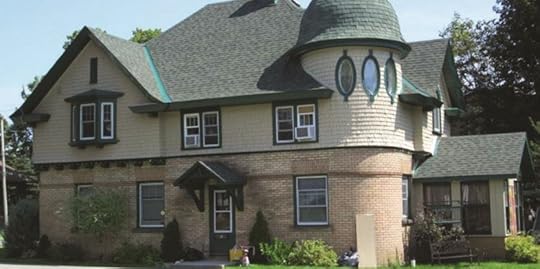
97 Chambers St. E., Smiths Falls –
The Carriage House located at 97 Chambers St. E is considered a significant heritage property because of its connection with its adjacent property, Elmcroft. It was the residence and workshop of Senator Frost’s full-time groundskeeper.
The carriage house, as it was called, stored all of Senator Frost’s horse drawn carriages on the first floor. They entered and exited where the veranda has been built on the end of the building.
Mansion Row Map

The homes of ‘Mansion Row’, Chambers St. , Smiths Falls, ON
These stately homes were all originally built and owned by immediate descendants of the Frost family, the founders of the Frost and Wood Company.
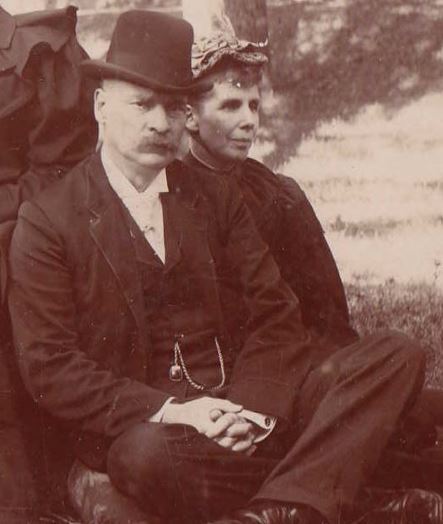
Senator and Mrs. Maria Eliza Frost relaxing on the grounds at Elmcroft
If you’re visiting Smiths Falls, be sure to drive along Chambers Street E. and enjoy the beauty of these historic mansions.
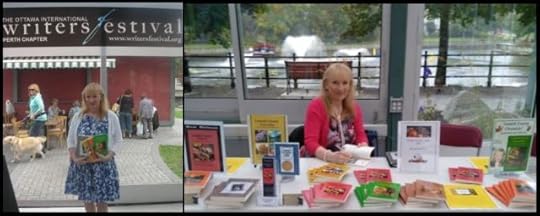
Arlene Stafford-Wilson
Member, Association of Professional Genealogists
Member, Lanark County Genealogical Society
Author of 10 books: “Lanark County Christmas”, “Lanark County Comfort”, “Lanark County Collection”, “Lanark County Calling”, “Lanark County Classics”, “Lanark County Connections”, “Lanark County Calendar”, “Lanark County Chronicle”, “Lanark County Kid”, & “Recipes & Recollections”
available at local stores or email: lanarkcountybooks@gmail.com
October 16, 2022
Calabogie Cottage Horror
It’s a dream of many, a summer escape, life along the lakeshore, with cold drinks, around a glowing fire-pit at night. Many of us imagine a tranquil place, with long lazy days, not a care in the world, boating, swimming, and dining on savory barbecued meals in the great outdoors.
It should have been the perfect way to spend a vacation, some well-deserved time off, relaxing, unwinding, but in a tale as strange as they come, a frightening chain of events ended with a young family packing up their gear, and speeding up Highway 511 toward Lanark, vowing never to return again.

It was late in the season when Mark saw the ad in the paper, a three bedroom cottage for rent by the week, with all the bells and whistles, and the price was right, in fact it was more than right, it was a downright steal. Perhaps the bargain basement cost for a luxury rental should have been the first clue that something was not as it seemed. When Mark saw the price, and that the place came with a boat for the week, he didn’t want to take a chance of letting this great deal slip away, so he called his wife, Jill, from the office. She gave the green light to go ahead and book it.
The kids had mixed reactions when they learned they’d be away from their friends, stuck with their parents for a week. “I don’t want to be out in the middle of nowhere, where there’s nothing to do!”, were the first words out of Josh’s mouth. Josh was 10, afterall, and liked to get together with friends and play video games. Caitlin, at 14, just didn’t want to be away from her friends. She and her friends liked to go back and forth between houses for sleepovers, staying up late, and watching movies.
Once the decision was made, Mark and Jill did their best to bring up all of the positive points about spending the week at a cottage. They could swim, fish, go out on the boat, have smores and toasted marshmallows around the fire at night; it would be a lot of fun, and it was only a week afterall, and they’d be back with their friends in no time.

Calabogie Lake, Renfrew County, Eastern Ontario
The drive to Calabogie didn’t take as long as they thought, and within an hour they’d unpacked, and the kids were getting settled in their rooms. Caitlin changed into her bathing suit, grabbed the sunscreen and headed out to the dock to work on her tan. After Jill and Mark filled the fridge, and put the bags away, Mark decided to check out the boat. He hadn’t driven one for a while and was anxious to get it out on the water, and see what it could do.

On the path from the cottage, he could see Caitlin face down on the dock, head resting on an inflatable pillow, and as he got closer he realized he was looking at the largest spider he’d ever seen in his life, just inches away from Caitlin’s shoulder. He yelled, “Caitlin, stay still, honey, don’t move!” Startled, Caitlin began to look around, spotted the enormous spider – about four inches in diameter, with black and grey striped legs, and she let out a blood-curdling scream, and ran frantically back toward the cottage. She told her mother what she’d seen and how large it was, and how she was not going back onto that dock again for the rest of the trip.
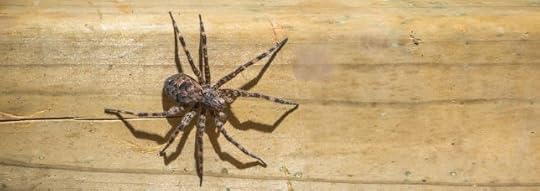
Meanwhile, Mark made his way down the dock, passed the spider, and continued toward the boat. Mark remembered an old wives tale he heard when he was a kid, something about killing a spider and then it rains. The last thing he wanted was rain on his vacation, so he walked past it, and stepped down into the boat. It had probably been twenty years since he’d driven a boat and he was excited at the prospect of touring around the lake all week. He put the key into the ignition, started the engine, removed the tie line, and pushed the throttle forward, heading out toward the center of the lake.

After a few passes around the lake, Mark headed back to the cottage, and slowed the engine as he approached the dock. Pulling up alongside, he grabbed the line to tie off the boat but he didn’t notice that a female spider had laid her eggs in the coils of the rope while he was gone. By the time he looked down, he had already plunged his hand into the wet sticky center, and sent hundreds of baby spiders in every direction. He jerked his hand back in horror, his fingers dripping with dozens of spiders, and then plunged his hand into the lake, thrashing his arm from side to side, frantically trying to remove what remained of the web and the spiders. After he’d managed to clean off his hand and arm, he glanced over at the tie line and saw that it was also covered with hundreds of spiders. He walked up toward the cottage, picked up a stick from the grass, and removed the rest of the nest from the tie line, then secured the boat.

Mark decided it was best to keep the story of his misadventures on the dock to himself, and waved at Jill as he made his way up the stone path to the cottage. The scent of the burgers on the barbecue was almost enough to make him forget his disturbing experience, and he called out to Jill, asking if she needed any help.

The barbecue was delicious, and in a rare moment, the kids actually seemed content. After supper Jill brought some marshmallows and smore-making supplies outside, and Mark used some crumpled paper to get a fire started in the fire pit. It was a beautiful night, a perfect pink sunset, the sound of loons along the shore, and the family enjoyed some great conversations and lots of laughs before deciding to pack it in for the night and head inside the cottage.

Josh was the first one off to bed, but it wasn’t long before he appeared at the doorway to his room. “I’m not sleeping in there.”, he said firmly, “My room is full of bugs.”
When Mark asked him what he meant, Josh led him into the room and when they turned on the overhead light, and looked up, there were dozens of large black dock spiders, crawling in every direction across the ceiling. He repeated himself, “I’m not sleeping in there.”

Jill came to the doorway, looked up at the ceiling, and tried her best not to react in front of the kids. She said, “Sure, Josh, you can sleep on the couch in the living room. No problem. We’ll take care of that tomorrow, and get the room all ship-shape for you.”
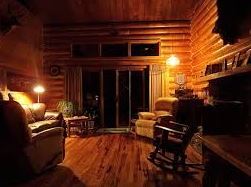
She headed toward the linen closet to get some extra bedding to make up the couch for Josh. She pulled the closet door open, and hundreds of spiders tumbled out onto the floor, and scattered across the living room, and into the kitchen.
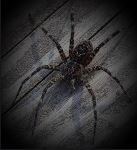
Jill looked at Mark, “We can’t stay here. I’m not staying here, and neither are the kids. Let’s go home now. Let’s just pack up our things and we can hope that we don’t bring any of these things back home with us.”

Mark agreed, and the family packed their suitcases, Jill took everything they’d brought out of the fridge, filled the cooler, and brought it out to the car. Within an hour, they were in the car and back on the road again, heading up Highway 511 toward Lanark.

Now Mark understood why the cottage rental had been so cheap. The owners hadn’t bothered to tell them in advance that the beautiful cottage was already fully occupied….not by people, ……………………………but by the infamous, and larger-than-life…….Calabogie Dock Spiders.

(Part of the Spooky October Tales series)
All characters are fictitious. Any resemblance to a person living or dead is purely coincidental. Dock Spiders are Canada’s largest spider, among nine species in North America. The mother spider’s ‘egg sack’ can hold up to 1,000 baby spiders. They have water-resistant legs and can walk on the surface of a lake, and even stay submerged for up to half an hour to avoid being caught by predators. These creatures are rarely aggressive toward humans, and normally hide when approached.
October: Tales of Fright from the Ottawa Valley
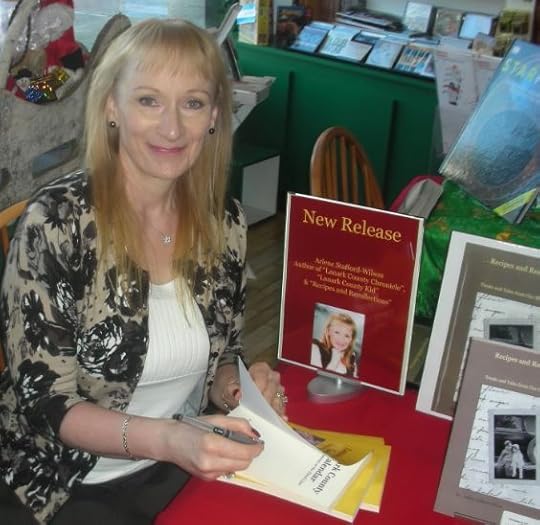
Arlene Stafford-Wilson
Member, Association of Professional Genealogists
Member, Lanark County Genealogical Society
Author of 10 books: “Lanark County Christmas”, “Lanark County Comfort”, “Lanark County Collection”, “Lanark County Calling”, “Lanark County Classics”, “Lanark County Connections”, “Lanark County Calendar”, “Lanark County Chronicle”, “Lanark County Kid”, & “Recipes & Recollections”
available at local stores or email: lanarkcountybooks@gmail.com
October 15, 2022
‘Witching’ or ‘Dowsing’ for Water

I often wonder what went through our Mother’s mind, when Dad informed her that there was no indoor plumbing in the farmhouse, on the Third Line of Bathurst, where they would be living, after the war.
They purchased the farm from Dad’s aunt and uncle, partly with the help of a Veteran’s Grant, in 1946, when Dad returned from overseas.
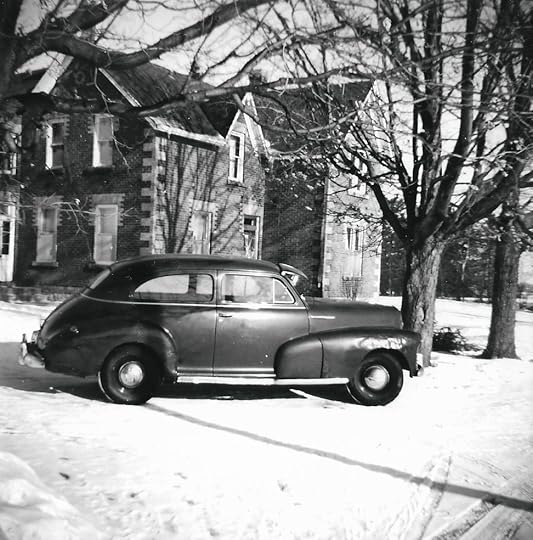
With two babies in diapers, I can’t imagine that my Mother was very happy at the prospect of drawing water from a well, with a hand-pump, a hundred yards from the house. There was a big cement cistern in the basement as well, which collected rain water, but that was just for washing, not drinking.
Water was often in short supply, and almost every year by summer’s end, the well was running dry. When Dad worked for Chaplin’s Dairy, in Glen Tay, he brought water home from the dairy at night, in big metal milk cans, to hold us over, for a while.
Drilling a well was an expensive project to undertake. People paid by the foot, and we’d all heard the horror stories about a neighbour or acquaintance, who had paid for drilling but had not ‘hit’ water in the process.
The practice in those days, back in the 1950s and 1960s, was to hire a ‘Switcher’, or ‘Diviner’, who would walk the property, and use a method called ‘Dowsing’. In fact, this was such a common practice at the time that I recall this technique being called by a few different names: Witching, Switching, and Divining, depending on who you were talking to.
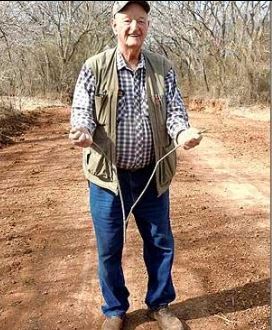
In many cases, a drilling company either had someone on staff, or knew a person with this skill, and brought them along to assist in finding the best spot to drill, where the water was closest to the surface.

The Thompson brothers, Jerry and Connie drilled our well, and they hired Jack Dowdall from Glen Tay, to walk the land with the apple branch to detect the water.
“I remember when a new well was drilled, and when the men came with the dowsing stick. I can’t recall when they called it – I think a divining stick or rod, but it was used to find water.
I was there, and asked if I could try it. The men seemed amused, but he told me what to do. I can’t remember if I felt anything or not, but when he found the water, it seemed to pull him and the stick almost down to the ground.”
Jackie Stafford WhartonI recall in those days they used a willow branch, or apple branch, and fashioned it so that it had two short ends, and one long end. Willow or apple was used to create the strongest ‘pull’ to the water. I’ve also heard that peach branches, or hazel branches conduct water in the same way.
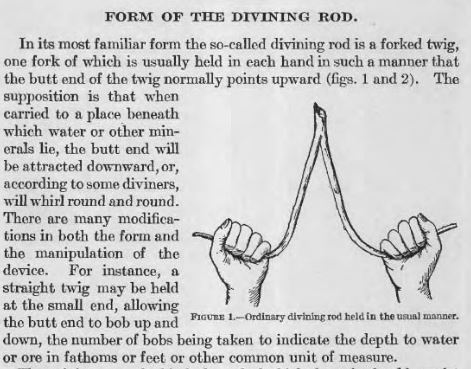
The practice of dowsing, goes back to the 15th century in Europe, where it was used not only to find water, but to detect metals as well.
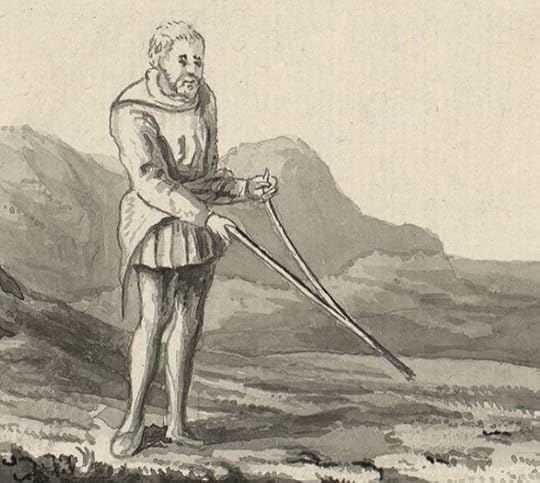
Dowsing or Witching was used extensively during the building of the railroad across Canada, to find drinking water for the crew, along the route.
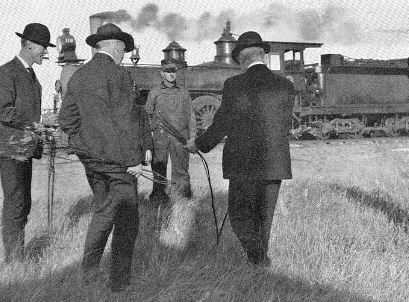
Farmers have used water-witching for generations, to determine the best place to dig their wells, and to find a source of drinking water for their cattle in a pasture.
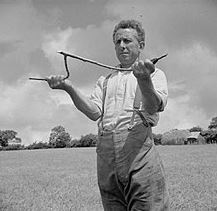
The practice continues to be used today, in some cities in Canada. Metal rods are used instead of the old-fashioned tree branches.

“The city (Ottawa) says it still routinely uses the age-old detection technique, also known as dowsing or water witching.
“Definitely the other technology works more consistently,” said Quentin Levesque, manager of what’s known as the city’s “locates group.”
“Should they have difficulties or troubles using the other equipment, the divining rod is there as well.”
The practice involves walking slowly over an area while holding one of the L-shaped rods in each hand. When the two rods cross, that’s supposed to signify the diviner is standing over water.”
Some Call it ‘A Gift’Can anyone use divining rods, or a willow switch to find water?
Some say it is a gift, and only those with this natural, intuitive, sensing ability can detect water. Some say that it doesn’t necessarily pass from father to son, or down through the family.
Some people claim that dowsing is a psychic ability, and some scoff and say that it is a learned ability, and that anyone can be trained to do it.
Whether it’s a gift, or something that can be learned, it’s still being practiced today by some, to pinpoint sources of water.
Were my parents happy when the well-witcher located the water in our yard, and the Thompson brothers drilled our well? They sure were!
Was it mystical or magical or other-worldly, when our Mother turned on the tap in the old house, and drinking water gushed out for the first time?
I’m sure to her, it was.
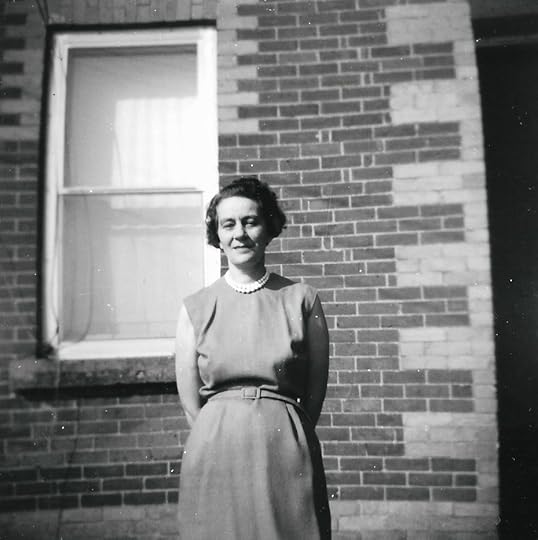
Jerry Thompson’s siblings: Vera (Percy Wills), Gordenia (Winfred Truelove), Marie (Maurice Wills), Gwen (Frank Turnbull), Connell ‘Connie’ (Phyllis North) Thompson, and Murray (Roberta Livingstone)Thompson.
Jack Dowdall’s siblings: Elizabeth (Clarence Donaldson), Violet (Lawrence Dixon), Lillian (William Kirkham), Laura ( Peter Kirkham), Edna (Joseph Kirkham), Mae (James McLaren), Edward (Mildred Foshay), Garnet (Margaret Stewart), William (Eleanor Gordon), George (Pearl Gordon), and Frank (Carmel Kirkham).
‘Meet’ Jerry, Connie and Jack, as they find the best spot to dig a country well, in the story: “Mysterious Ways of the Water Witcher”,
in the book – “Lanark County Collection” ISBN 978-0987-7026-78
(available at The Book Nook in Perth https://thebooknookperth.com/Spark Books and Curios 76 Foster Street, Perth, Ontario https://sparkperth.ca/Mill Street Books in Almonte, https://millstreetbooks.com/or online at https://staffordwilson.com/
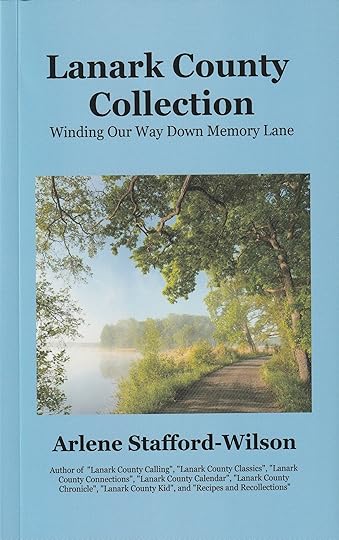
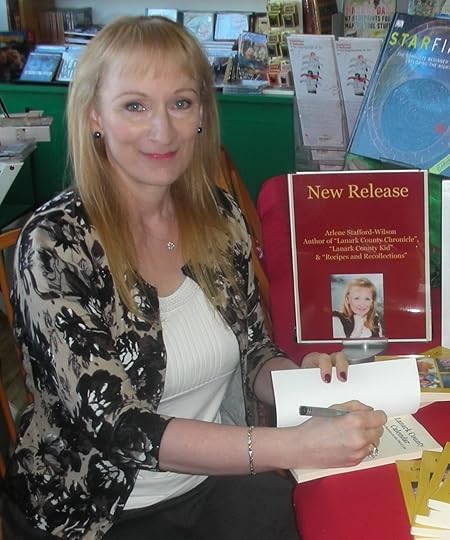
Arlene Stafford-Wilson
October 14, 2022
The Witch of Plum Hollow
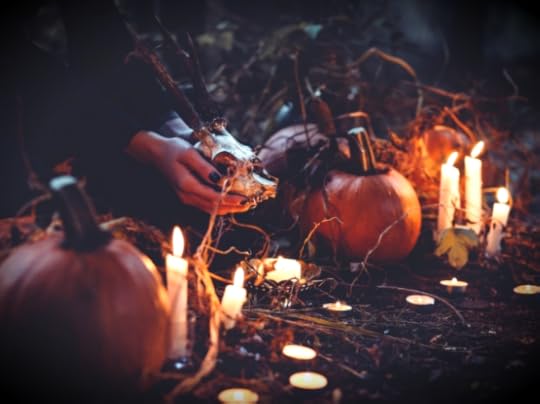
The readings always began the same way, with her visitors climbing the rickety wooden stairs to her cramped attic reading room. She motioned her guests to sit across from her, at a small pine table. A fresh pot of tea sat on the table, along with two cups. She’d pick up the pot, shake it vigorously, and pour a cup, watching as the leaves slowly sank to the bottom. Next, she swirled the tea around, poured the liquid back into the pot, then instructed her visitor to do the same.
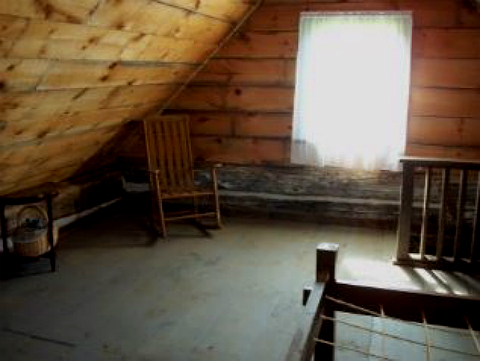
Jane Elizabeth Martin Barnes was a beautiful young woman, when she arrived in North America. She left her home in England after refusing to marry a man twice her age. Her father, a Colonel, had instructed her to wed his friend, an unattractive middle-aged soldier, and Jane would have no part of it. Instead, she fell in love with a handsome young man, Robert Harrison, and they left Britain together, married, and had a son.
Sadly, Robert died shortly after they settled in Ontario, and Jane was left alone to raise their baby.
Jane had a lovely slim frame, fair complexion, and bright eyes. It wasn’t long before she began to date again, and a young shoemaker, David Barnes, won her heart. They married, and settled near Lake Eloida, not far from Plum Hollow, about fifteen miles south of Smiths Falls, in Leeds & Grenville, Ontario. Jane and David had a large family – six sons, three daughters, and Jane took in three neighbourhood orphans after their mother passed.
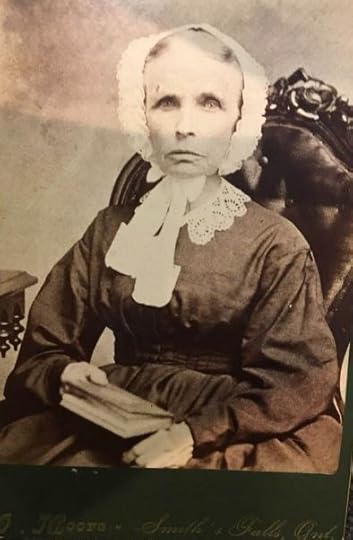
Jane’s husband David, was a bit of a wanderer, and he left her, abandoned the children, and moved to Smiths Falls. After her husband left, Jane’s son Williston ‘Ton’, and his family, moved into the little cabin with Jane, to offer her support.
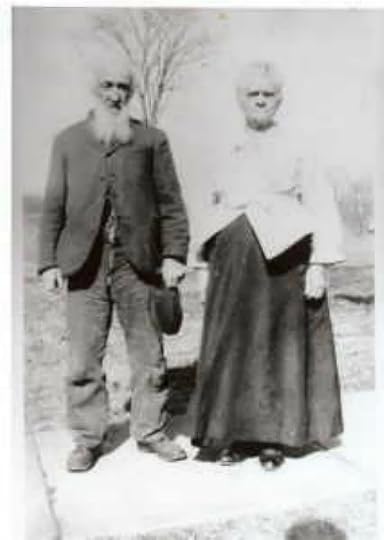

David Barnes, Jane’s estranged husband, moved in with their son Samuel Barnes, who had a home in Smiths Falls, and who later became Mayor.
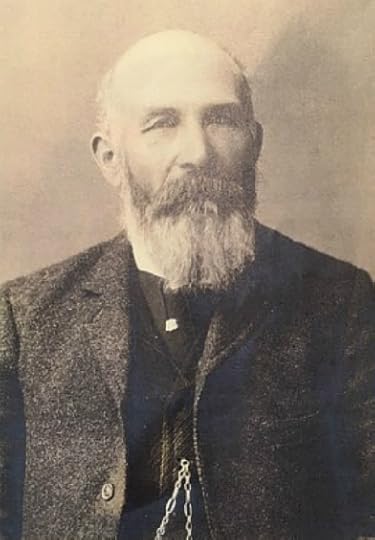
Samuel Barnes was among several other prominent business leaders who brought about the incorporation of the ‘Smiths Falls, Rideau, and Southern Railway Company‘, in January of 1898. The purpose of the incorporation was to construct and operate railways in, through and from the Town of Smiths Falls, in the County of Lanark.
The other members were James Maitland Clark, John Reeve Lavell, Alpheus Patterson, Richard Alexander Bennett, Matthew Ryan, Robert J. Brodie, Adam Foster, Robert Hawkins, George T. Martin, and Alexander Gray Farrell, all of the Town of Smiths Falls.
Samuel married Agnes Chalmers, and they had a large family of 10 children. Their youngest was Roy Barnes.
Roy Barnes in 1947, Grandson of Mother Barnes (Witch of Plum Hollow)
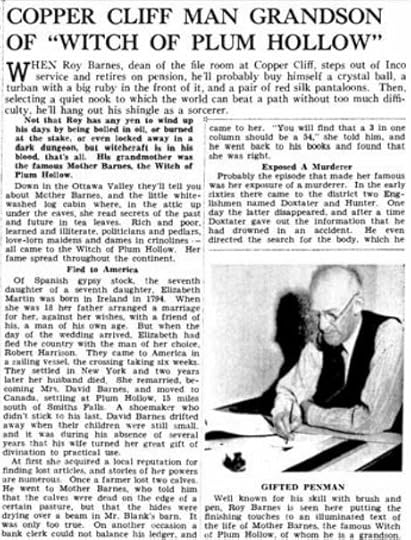

Jane, in need of an income to raise all of their children, began to read tea leaves.
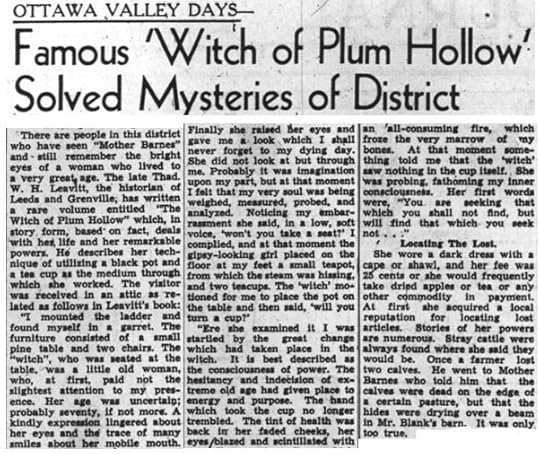

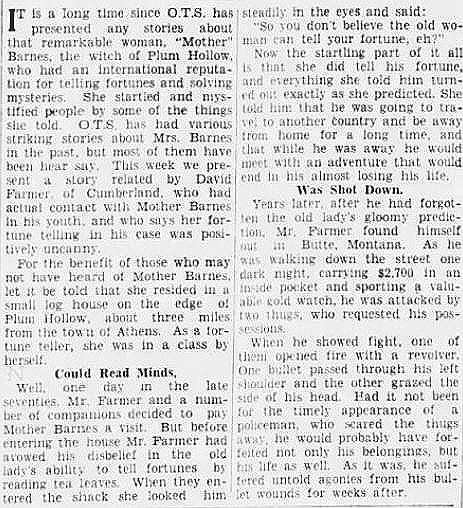

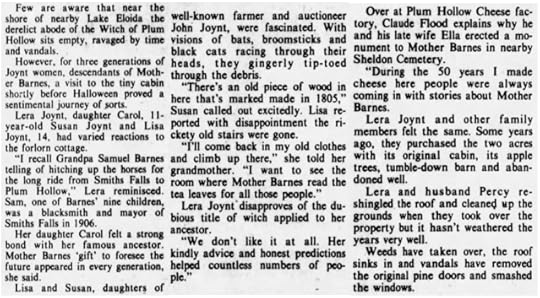
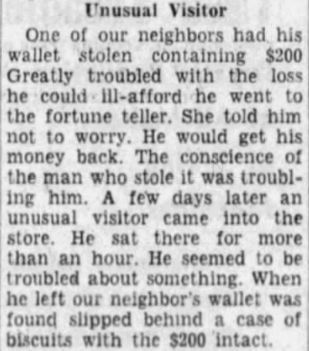
In the late 1800s, telling one’s fortune by reading tea leaves became very popular.
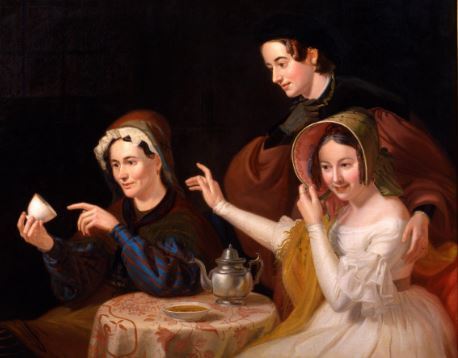
In those days, loose tea was used, and so the leaves at the bottom of the cup often formed shapes or patterns, and these were interpreted by the fortune-teller, to predict future events.

Loose tea was measured into a tea pot filled with boiling water. After the tea was consumed, the loose leaves lay at the bottom of the cup
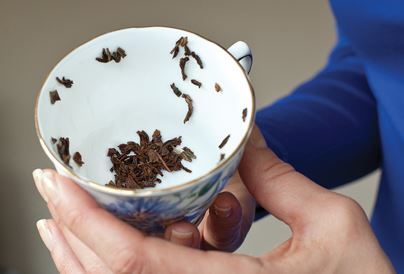
Then, the fortune-teller, or tea-leaf-reader, would interpret the meaning of the individual’s leaves.
Many believed that the position of the leaves in the cup itself, had meaning.


The images of the leaves in the cup were often matched with a series of standard symbols, used by many in the trade.

News of Jane’s accuracy in her predictions spread quickly, and she had visitors from neighbouring towns, cities, provinces, and even visitors from the northern states.
One of her most famous customers was the future Prime Minister of Canada, John A. MacDonald.

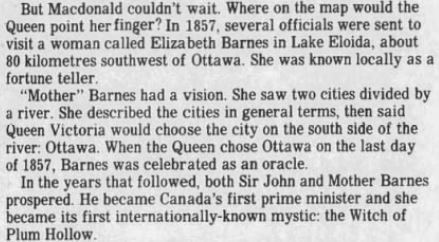
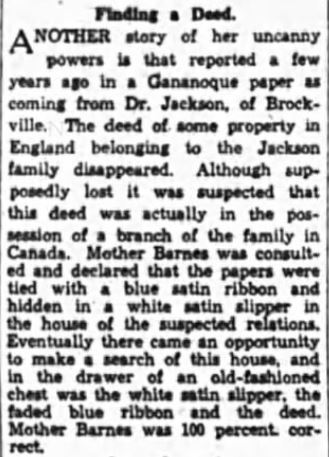
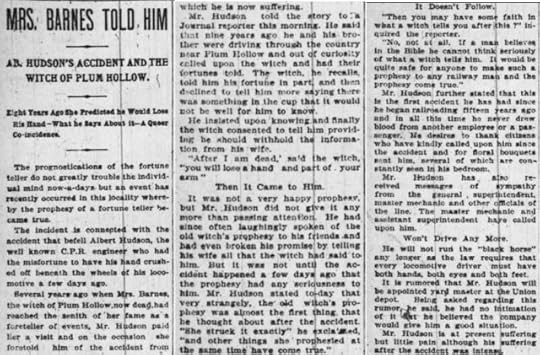
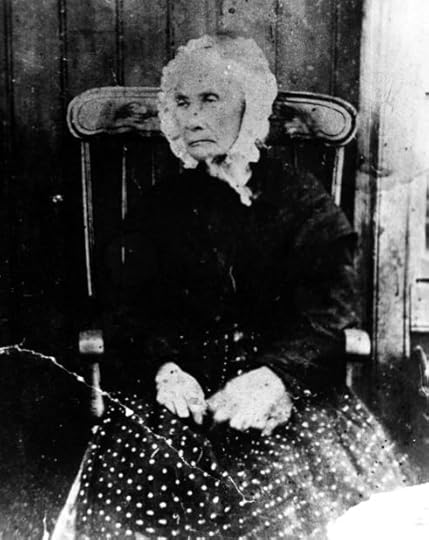
“As promised, we shall, here and now endeavor to do justice to the memory of a lady of the old school, who truly had as keen and as well trained and as thoroughly disciplined an intellect as anyone of our day and generation in our beloved native county. We refer to our long ago departed and much respected fellow citizen, who was early known as “Mother Barnes”, who as her years increased was usually designated as “Old Mother Barnes” and who was unjustly, and with crude irreverence, spoken of by those who knew her least as “The Witch of Plum Hollow.” The Old Farmersville folk never called her by such a name, nor did any of her neighbours who knew her best, for all who were intimate with her respected her and treated her with deference. It is true that she had a sharp tongue, but the only folk who ever felt its stinging lash were those from far distant parts who at times came into her presence with boisterous demeanor. She was pre-eminently fitted to handle just such a case and in a few crisp quietly spoken, even gentle words, she promptly put the culprit in his place and engendered in his heart and mind an infinitesimally small estimate of his own worth and importance in affairs terrestrial and in divine matters of the spirit world. Such a smart visitor went away dazed and with a deep realization of the fact that here in the backwoods of Canada was a personality which dominated everyone and everything in a manner far transcending that of any of the national orators, preachers, politicians, lecturers, phrenologists and other celebrities then the vogue in New York, London, Paris. This characteristic, and her native ability to see right through everyone, and even turn their minds and thoughts inside out, after a few moments’ conversation: these two God-given attributes made Mother Barnes famous and compelled the people to beat a track to her door to her little tea studio up under the eaves, for many long years.
If anyone wishes to make a shrine of the old home of Mother Barnes, which would be a fitting way to perpetuate her memory, he can easily locate the house by turning north from Main Street, Athens, at Sydney Taplin’s old corner, now owned by Mrs. Avis Daniels Harte. He should then proceed along Elgin Street, past the Area Parish Memorial Park on his right, and so along Livingstone Avenue, past the Villa to the Guide-board corner. Here, he should turn neither to the left along Wright Avenue to Plum Hollow, nor to the left along Robeson Avenue to Hard Island. He should keep straight ahead north along Eliada Parish Avenue to Mother Barnes Avenue, which is the town-line between Yonge and Kitley. There, on the southwest corner is Mother Barnes’ old home, Lot 13, Concession 11 Yonge. Mother Barnes Avenue runs from Atkins Lake, north of Rockspring, through Eloida, all the way to Soperton.
Mother Barnes was born Elizabeth Martin. She was a dearly loved daughter of Col. Martin, of the British Army, but when she came of age, she ran away with the man of her choice, Sergeant Robert Harrison, coming to America in a sailing ship which took six weeks in crossing. Thus, having disobeyed the wishes of her parents, she was a stranger to them during the rest of her pilgrimage below, true to the then prevailing mode in English families of the military, clergy, and gentry class. Elizabeth ‘Jane’ Martin, and her husband settled in Cobourg, Upper Canada, where one son, Robert Harrison Jr., was born to them, who in later life became Colonel Robert Harrison, commanding officer of a regiment from Kansas in the American Civil War. Col. Robert Harrison died in Kansas, and his mother in her home, at the corner of Mother Barnes and Eliada Parish Avenues, had his pictures in full regimentals. After the death of her husband, Robert Harrison, the elder, Mother Barnes, then known as Mrs. Elizabeth Martin Harrison, married David Barnes, an American, by whom she had nine children. John and Thomas died in youth. Next came Lucy, born in 1837, who married Joseph Haskin, of Plum Hollow. They moved to Modale, Iowa, travelling in a covered wagon. After the death of her husband, Lucy married a cousin of our dear old neighbour, Horace Brown, of Farmersville. She last visited her Athens cousins in 1906 but died some years ago. Next, came Samuel Barnes, a blacksmith, who married Agnes Chalmers of Montague, near Smiths Falls, a cousin of our old chum, Will Chalmers. Their daughter, Mrs. Lily Barnes, still resided in Smiths Falls when the record was made a few years ago. It was in the home of Mrs. And Mrs. Samuel Barnes, Smiths Falls, that David Barnes, husband of Mother Barnes, died. The next child was David Barnes, also a blacksmith. He went to Iowa in early life and died there. Next came Margaret, who married Arthur Robeson, of Sharbot Lake, where she died. Next came George of Athens, who married Clare Kyo, of Watertown, N.Y., and died young. Next, came Williston Barnes, of Eloida, who married Lydia Compo. Last came Jane Elizabeth Barnes, (Janie) born March 1st, 1847, who was the wife of our very popular old neighbour, Charlie Wing, of Farmersville. Mrs. Wing died Nov. 10, 1910. In one of our stories we described the home of Mr. and Mrs. Wing, on Elgin Street, which was one of the neatest, best kept and most attractive in the village. An adopted daughter of Mother Barnes and her husband David was Bella Sheldon, who was the wife of our cheerful old neighbour, Erastus Livingston.
And now we feel better, for we have completed a pleasant task, which has confronted me for a long time. We wanted to do justice to Mother Barnes, but it is not until now that we have been able to get around to it. We think that our good friend, Prof. Fred Lawdon, of the Historic Sites and Monuments Board, should see to it that the site of the old home of Mother Barnes is suitably marked for the enlightenment of posterity. Canada has never had as one of its citizens a lady of stronger character or keener intellect than Mother Barnes and this brief story of her life, which will be permanently preserved in the Canadian Archives, should be called to the attention of posterity by a suitable marking of the place of her residence and the centre of her activity, her old home near Lake Loyada (Eloida). Thus, Elizabeth Martin, a daughter of the gentry of England, lived among us for three-quarters of a century. What did she think of us? If she had put her impressions in the form of a book, it would now have an enormous sale.”
She predicted the location of money stolen from a resident of South March
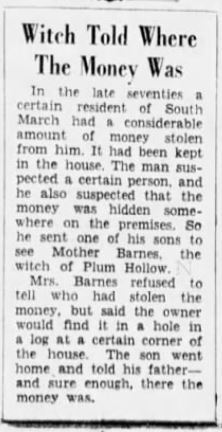
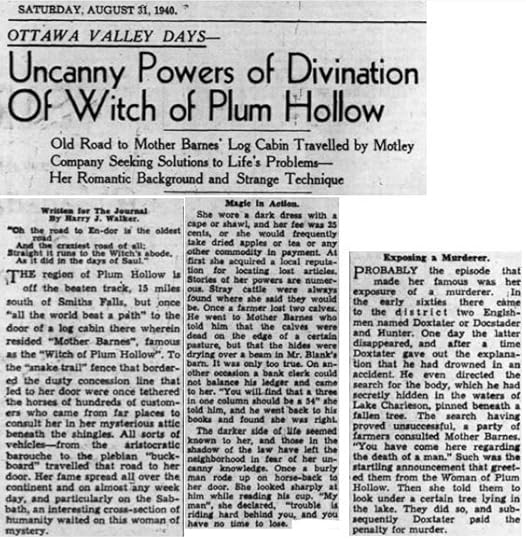
During Jane’s time telling fortunes she was able to find missing objects, missing farm animals, and even missing people. Jane’s predictions were so accurate that even the police called on her to assist them from time to time. She even had a few very famous customers, in the many decades of her practice, in that little cabin in the country.
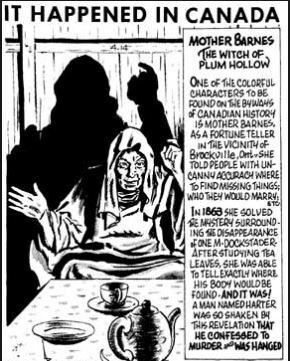
As the decades passed, news about Jane’s gift for predicting continued to spread far and wide, and there were often carriages lined up down the road near her little cabin.
“It was alleged by many, that Mrs. Barnes could tell all about a person, a hair from whose head was presented to her.”
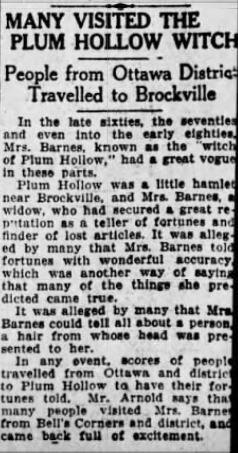
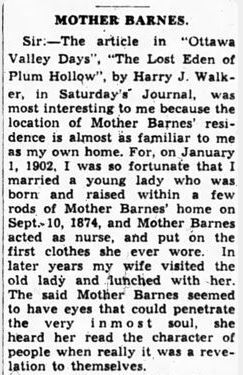
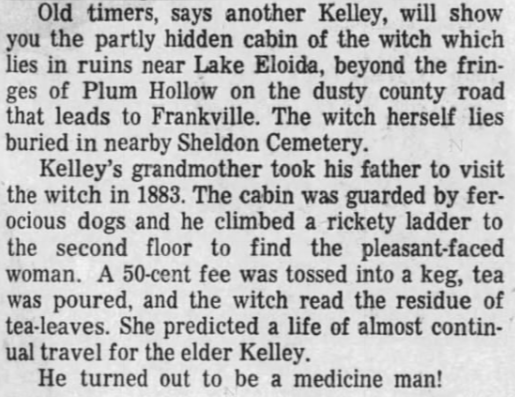
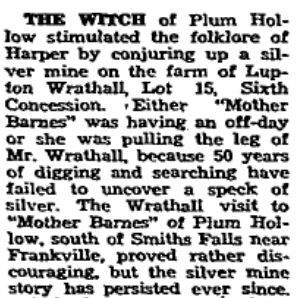
Young people went to Jane, to ask advice on their love lives, and she was able to predict who they would marry. If any of the neighbours misplaced anything, they walked to Jane’s little cabin and she would tell them exactly where to look. Farmers went to Jane when their cattle or horses wandered off, and she always directed them to precisely the right spot. Business people consulted Jane for advice on their professions, and politicians sought her advice on elections and policies.
“The walls in the little room downstairs, were closely covered with the names of people from Canada and the United States, who had come to have their fortunes told.”
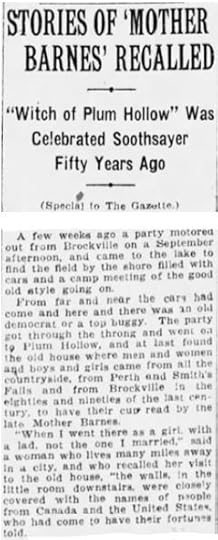
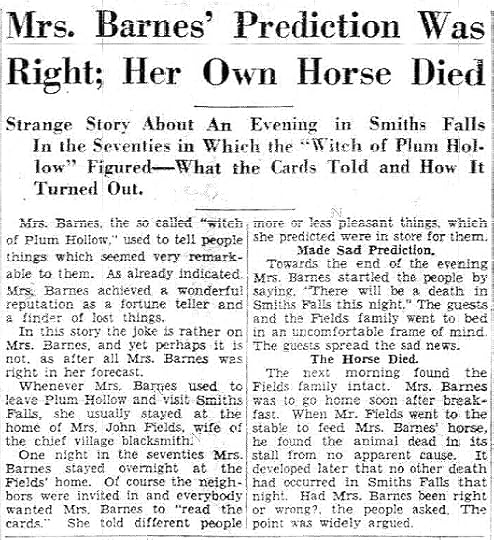
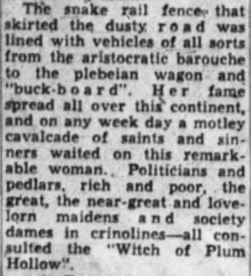
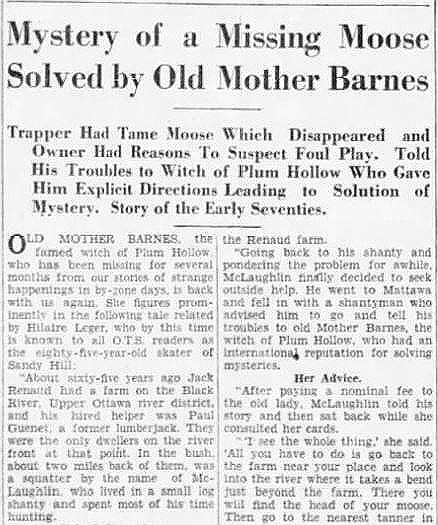
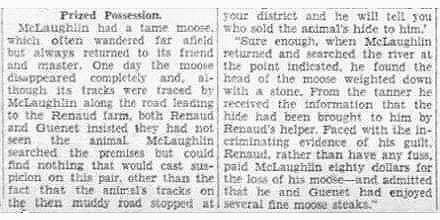
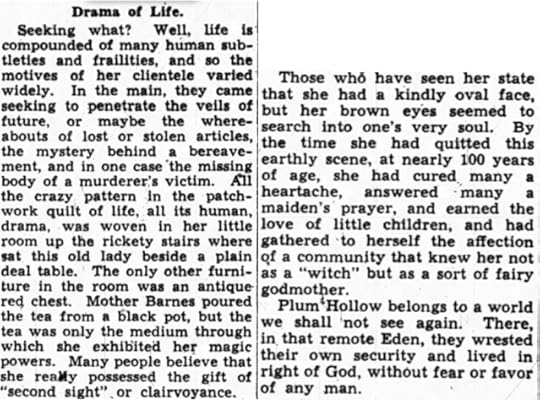
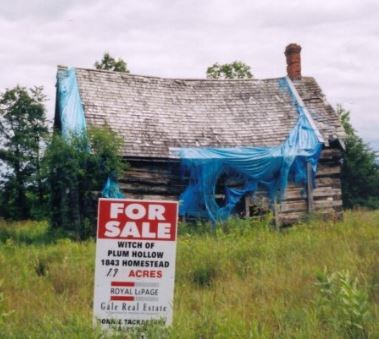
Eloda Wachsmuth, of Navan, Ontario, purchased the cabin in 2005, and invested $35,000 to restore the home, using much of the original logs and lumber in the restoration. Eloda wanted to preserve the history of Jane Barnes, so that she would be remembered.

By the fall of 2007, the cabin was restored, and it was Eloda’s intention that it would be open to the public, so they could learn about Jane Barnes and her years spent as a well-known fortune-teller.
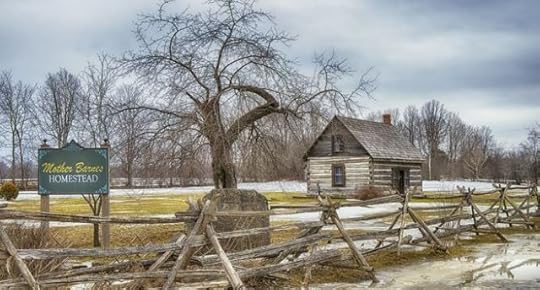
Mother Barnes, as she was affectionately referred to in Leeds, lived a long life, and passed away, at the age of 90, in that same little cabin, where she had shared her predictions over the years.


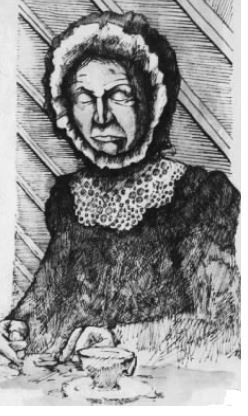
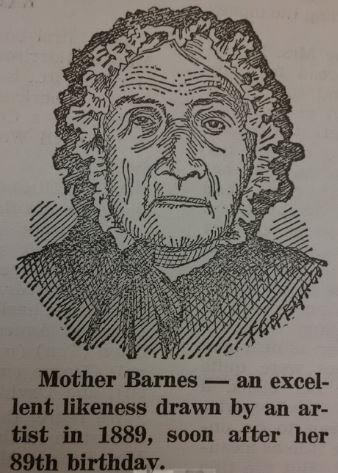
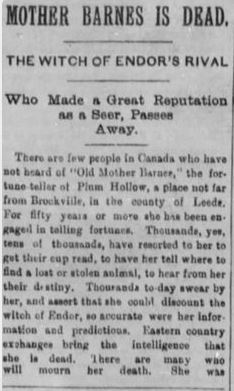
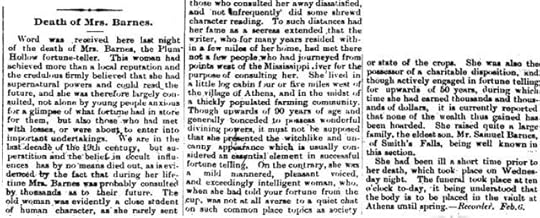

Jane is buried at the Sheldon Cemetery
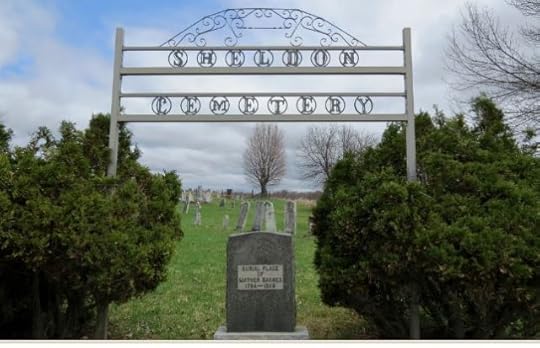
When Jane passed, she was buried in an unmarked grave.
Plum Hollow cheese-makers from 1924-1974, Claude and Ella Flood, erected a stone in memory of ‘Mother Barnes’. (note: the dates on the stone are incorrect)
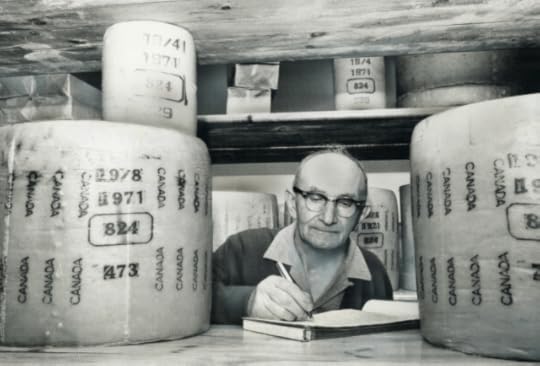

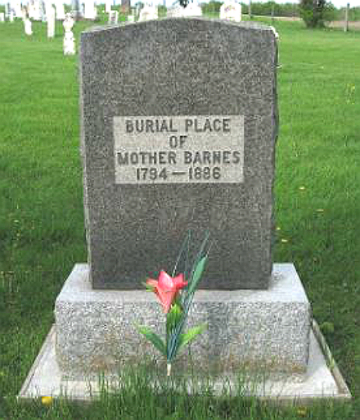
Robert J. Harrison Jr. 1829-
John Barnes 1831-1832
Margaret Barnes 1832-1891
Thomas Barnes 1833-1857
Lucy Barnes 1836-1929
Samuel Barnes 1837-1922
David Barnes 1840-1923
Williston Barnes 1845-1920
George Barnes 1846-1906
Jane ‘Janie’ Barnes 1847-1910
Bella Sheldon 1853-1935
Descendants of Mother Barnes:Jane had a large family, including three adopted children.
Her son David Barnes died in infancy, age 1, and her son Thomas Barnes lived only until age 24.
Her eldest daughter, Margaret ‘Maggie’ Barnes, at the age of 52, married James Robinson.
Her daughter, Lucy Barnes married Metcalfe Peer, Joseph Haskin, and Alva Brown
Her son, Samuel Martin Barnes married Agnes Chalmers
Her son, David Barnes married Fannie Ryel
Her son, Williston ‘Ton’ Barnes, married Lydia Compo
Her son, George W. Barnes married Clarissa ‘Clara’ Kio
Her daughter, Jane, married Charles Wing
Other surnames in ‘Mother’ Barnes family: Bell, Joynt, Cooper, Goodwin, Williams, Buchanan
………………………………….
Discover the fascinating story of Jane Barnes, and her years as a local fortune-teller. Find out about some of Jane’s most prominent and famous customers. Who were the high-profile movers and shakers who sought Jane’s advice on a regular basis? Read about a grisly murder case that perplexed police, and was finally solved by Jane. Who was the famous and controversial newspaper publisher who sent his wife to ask Jane’s predictions because he didn’t want to be seen visiting a ‘fortune-teller’. Learn about the case of a poltergeist in Quebec, where the family seeks Jane’s help in solving the violent and frightening haunting of their house. Discover these stories and more, in the book:“Lanark County Calling: All Roads Lead Home”, the complete story of Jane Barnes, a gifted lady, also known as – ‘The Witch of Plum Hollow” ISBN 978-0-987-702661Arlene Stafford-Wilson
Member, Association of Professional GenealogistsMember, Lanark County Genealogical SocietyAuthor of 10 books: “Lanark County Christmas”, “Lanark County Comfort”, “Lanark County Collection”, “Lanark County Calling”, “Lanark County Classics”, “Lanark County Connections”, “Lanark County Calendar”, “Lanark County Chronicle”, “Lanark County Kid”, & “Recipes & Recollections”available at local stores or email: lanarkcountybooks@gmail.comOctober 13, 2022
Scottish Hallowe’en
Hallowe’en in Scotland goes back to the time of the Celtic pagans, and it was known as the feast of Samhain. Samhain marked the end of summer, the beginning of winter, and was the night when the veil between the living and the dead was at its thinnest. The Celts believed that spirits could travel freely back and forth between the two worlds, and so, over time, special customs and traditions became woven into the Scottish culture. Fires were lit to ward off evil spirits, and burned throughout the night, until dawn the next morning.

After All Saints Day was established, and became a religious tradition, on November 1st each year, the Scots began to favour the Christian celebration, and the pagan rites on October 31st became less important, until they eventually diminished into the more secular Hallowe’en traditions that remain today.
Carving Neeps
Instead of carving pumpkins, the Scottish tradition is to carve turnips, or as the Scots refer to them, “neeps”. These are far more difficult to carve, being almost solid in consistency. Originally, during pagan times, these were used as lanterns, when someone was walking from place to place, on Samhain. If someone couldn’t be near the village fire, which would ward off the evil spirits, they carved a frightening face in a turnip, placed a candle inside, and carried it with them as they walked around, hoping to scare off anyone, or any ‘thing’ that approached them.

Guising

“Guising”, is the Scottish term for dressing up in a Hallowe’en costume. In the old times, of the Celts, parents would dress up their children and disguise them as ghouls and monsters. Their reasoning was that the real spirits would leave them alone if they thought they were already ghouls. It was a form of protection for the chidren so their souls wouldn’t be stolen in the night. Adult members of the community often practised this as well, dressing up as ghouls and goblins to protect their own souls.
Dookin’ for Apples

“Dookin'”, (or dunking) for apples, can be traced back to the Celtic traditions of Samhain. In this game, the participants try to catch an apple in their teeth, in a deep basin of water. Once the apple was caught, it was peeled, and the peel was thrown over the left shoulder. The shape of the peel where it fell on the floor was said to be the first initial of your future spouse.

Robbie Burns,
“Hallowe’en” Poem
There’s an old poem by Robbie Burns, written in 1795, which tells of some of the Hallowe’en customs that were practised at that time in Scotland. In the second verse of his poem he writes:
“Some merry, friendly, country-folks
Together did convene,
To burn their nits, an’ pou their stocks,
An’ haud their Hallowe’en
Fu’ blythe that night…..”
(Translation: People got together, burned some nuts, and pulled some plants)
Burning Nuts

Engaged Couples
Engaged Couples – On Halloween they each put a nut on the fire. If the nuts burned quietly then the marriage would be happy, but if the nuts and hissed and spat then their marriage would be filled with conflict.
Single Girls
Single Girl – It was customary for a single girl to put two nuts on the fire, one for her boyfriend, and one for herself, and if the nuts hissed, it was a sign of fighting and discord in their future together. If the nuts sat quietly in the fire then they would have a peaceful relationship.
Pulling Kale
or Cabbage
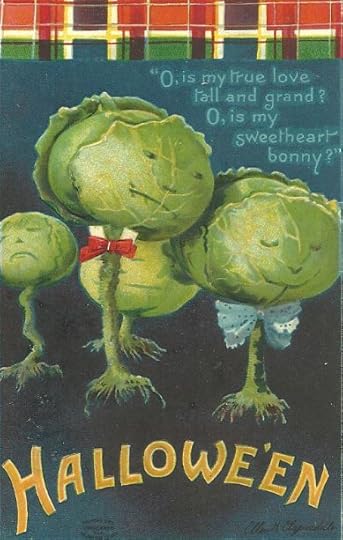
It was customary for single men and women to pull kale or cabbage stocks from the ground after dark, with their eyes closed.

The shape and size of the stock would foretell of the shape and height of your future spouse.
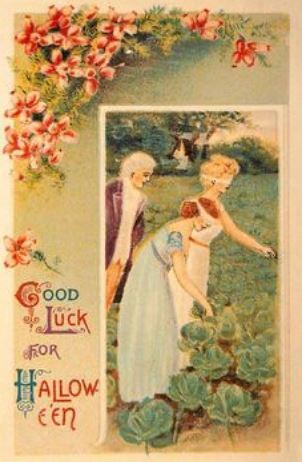
If there was a lot of earth remaining on the stock it was a sign of prosperity.
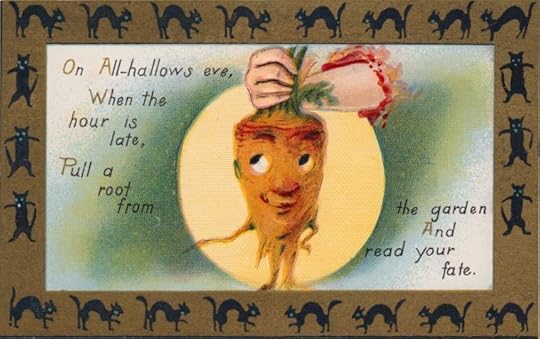
Scotland Today
Today, some of the old traditions are still celebrated on Hallowe’en in Scotland, and one of the most famous is the annual Samhain Fire Festival in Edinburgh.
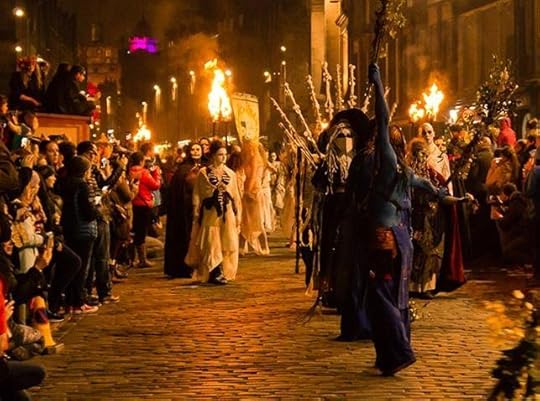
High on the top of Edinburgh’s Calton Hill, costumed artists still gather each year and use fire, music, and dance to tell the old stories for the crowds that gather.
From the old pagan traditions, to the modern day celebrations, Hallowe’en is alive and well in Scotland.
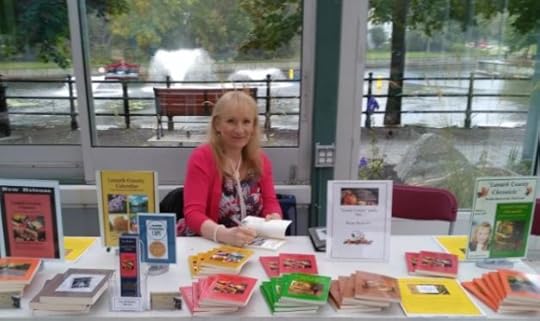
Arlene Stafford-Wilson
Member, Association of Professional Genealogists
Member, Lanark County Genealogical Society
Author of 10 books: “Lanark County Christmas”, “Lanark County Comfort”, “Lanark County Collection”, “Lanark County Calling”, “Lanark County Classics”, “Lanark County Connections”, “Lanark County Calendar”, “Lanark County Chronicle”, “Lanark County Kid”, & “Recipes & Recollections”
available at local stores or email: lanarkcountybooks@gmail.com
October 12, 2022
Ghost of Ferguson’s Falls

James (Jimmy) Phelan (pronounced Whelan)
Who is the Ghost
of Ferguson’s Falls?
The old-timers said that her name was Mary, a good Catholic girl, from Ferguson’s Falls, who lived just down the hill from the church; but there’s no one left around anymore who knew her. They say she died at home, alone in her bed, a photo of Jimmy clutched in her hands. She never married, although there was always an abundance of interested young lads eager to spend time with tall willowy Mary, a porcelain-pale beauty, with flowing red hair, and the face of an angel.
Mary’s fate, you see, was sealed, the night she heard that her Jimmy was gone forever, drowned in the cold autumn waters of the Mississippi River. Her handsome young log-driver, killed in a log jam. Jimmy was her one true love, and she never got over his death, and couldn’t accept the fact that they’d never be together again.
Gates of Glass
It wasn’t long after Jimmy’s funeral at St. Patrick’s Church, that Mary began to walk along the banks of the river, sometimes in broad daylight, but mostly at night. Some say she was hoping to meet up with him again, and that she believed in the old Irish legends of the ‘gates of glass’. It was one of the beliefs brought from the old country – when the river was still and smooth, that spirits could pass between the two worlds, from our world to the world beyond, and back again. It was believed that the water became a portal, and the Irish called it the gates of glass.
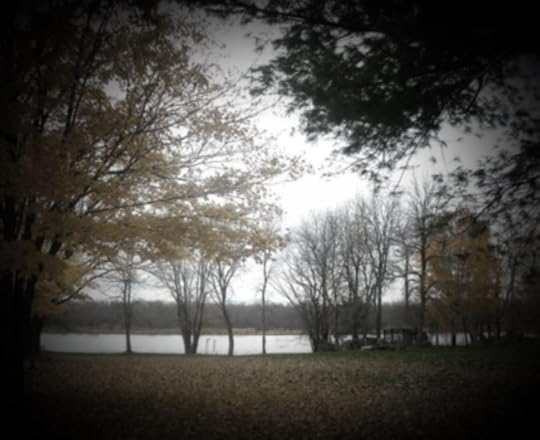
Ferguson’s Falls, autumn, along the river
Mary’s walks along the river went on for many years. They say she was quite a sight at times, in her long flowing dressing gown, often late in the evening, to avoid the questions and the prying eyes, searching for a quiet place where the water was still, hoping to open the gates of glass and reunite with her beloved.
A Letter from
Christopher Forbes
From a letter written in 1923, by Mr. Christopher Forbes, of Perth, Ontario:“The Phelan family live in this district. The name is pronounced ‘Whalen’, locally. James’ brother, Thomas, whom I knew intimately, died a few years ago. Regarding the James Phalen tragedy, John Smith of Lanark Village, an old timer and singer of the ‘come all ye’ type, wrote the words which I now enclose. He sings the Jim Whalen song with much pathos, and with that peculiar dropping off of the last word from a singing tone to a speaking voice. This style of finishing a song is used by sailors and shanty-men.
I was fortunate in meeting an old shanty foreman, Peter McIlquham, well known on the Mississippi River for over half a century, who told me he was present at Jim Whelan’s death.
It happened 45 years ago (1878), at King’s Chute, on the Mississippi River. Whalen was a river-man under ‘Old Quebec’, a French-Canadian, whose real name was Edward Leblanc. McIlquham was also a foreman on the river at this time. Both rafts of longs had come out of Crotch Lake by the river-men. McIlquham came to assist Old Quebec putting over King’s Chute. A dangerous and difficult jam formed in the Chute. ‘Old Quebec’, McIlquham, and Phalen were close together when the jam shifted, and precipitated Phalen into the water.”

May 26, 1876, p. 3, “The Perth Courier”

Gravestone of Jimmy Phelan, and his parents, James Phelan, and Margaret O’Brien Phelan, St. Patrick’s Cemetery, Ferguson’s Falls

The sign as you enter the village
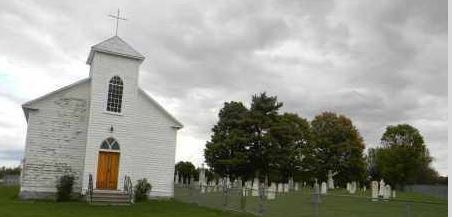
St. Patrick’s Church and cemetery, Ferguson’s Falls, Ontario
The Ballad
of Jimmy Whelan

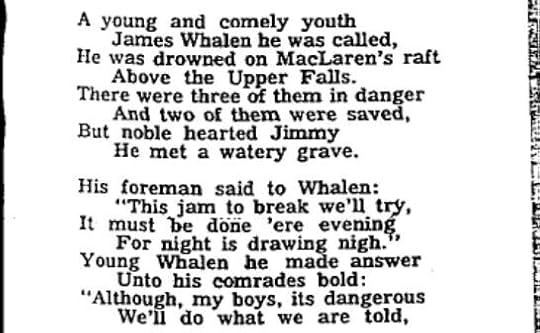
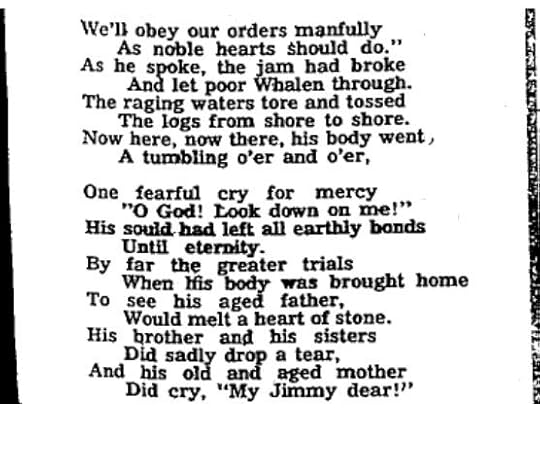
September 20, 1962, p. 8, “The Perth Courier”
Lost
Jimmy Whelan
Like the tale itself, there are two different authors given credit for writing the song – Tim Doyle, of Drummond Township, and John Smith, of Lanark. There was also more than one ballad composed, and the latter, “Lost Jimmy Whelan”, was written about his beautiful young lover, as she wanders beside the Mississippi River, at night, searching for Jimmy.

Lost Jimmy Whelan
All alone as I strayed by the banks of the river,
Watching the moonbeams as evening drew nigh,
All alone as I rambled, I spied a fair damsel
Weeping and wailing with many a sigh.
Weeping for one who is now lying lowly,
Mourning for one who no mortal can save.
As the foaming dark water flow gently about him,
Onward they speed over young Jimmy’s grave.
She cries, “Oh, my darling, please come to me quickly,
And give me fond kisses that oft-times you gave.
You promised to meet me this evening, my darling,
So now, lovely Jimmy, arise from your grave.”
Slowly he rose from the dark, stormy waters,
A vision of beauty more fair than the sun,
Saying “I have returned from the regions of glory
To be in your dear loving arms once again.”
“Oh, Jimmy, why can’t you tarry here with me,
Not leave me alone, so distracted in pain.”
“Since death is the dagger that’s cut us asunder,
Wide is the gulf, love, between you and I.”
“One fond embrace, love, and then I must leave you;
One loving farewell, and then we must part.”
Cold were the arms that encircled about her;
Cold was the body she pressed to her heart.
Slowly he rose from the banks of the river,
Up to the heavens he then seemed to go
Leaving this fair maiden, weeping and mourning,
Alone on the banks of the river below.“

Although she’s been gone for many decades, some say they still see Mary, late at night, strolling along the Mississippi River, in Ferguson’s Falls, searching for Jimmy.

Along the Mississippi River, the Stumble Inn, Ferguson Falls – a spot where Mary’s been sighted numerous times over the years
She’s often seen in a long white gown, her fiery red hair cascading down her back, and sometimes she appears to be almost gliding ever-so-lightly along the shores. Is she still searching for that smooth calm water, that portal between the worlds of the living and the dead, to reunite with her Jimmy through the gates of glass?

Will this beautiful apparition in her flowing white gown forever be known as the Ghost of Ferguson’s Falls?

Arlene Stafford-Wilson
Read more about the life and death of Jimmy Whelan, and the stories of the beautiful young lady who walks along the river at night searching for her long lost lover.
“Lanark County Calling: All Roads Lead Home”
ISBN: 978-0-987702661
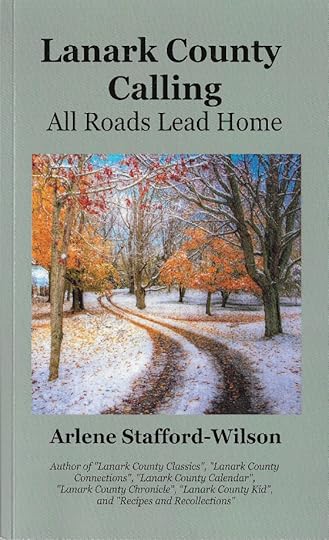
Available at, The Book Nook, Perth, Ontario, Spark Books, Perth, Ontario, Mill St. Books, Almonte, or contact: lanarkcountybooks@gmail.com
October 11, 2022
Perth Museum’s Ghosts
Perth, Ontario, is home to a number of beautiful old limestone buildings, dating back over 200 years. It’s not surprising that during this long history there have been many reports from residents, visitors, and employees of paranormal activity in the museum, located on the main street of the town, Gore Street. Some have claimed they heard unusual sounds, saw unexplained shadows, heard voices, thumping noises, or felt sudden chills or gusts of air at this old Perth landmark.
Have you experienced paranormal activity?1. Disappearance and re-emergence of objects in the house
2. Finding unidentified objects in the house
3. Appearance of unexplained marks around the house, e.g. scratch marks on the walls, odd marks on cupboards or walls
4. Hearing sounds of doors closing or opening, banging, laughter, walking, speaking, etc. in the absence of any source
5. Sudden changes in temperature
6. Lights or electronic equipment going on or off repeatedly or not working without any reason
7. Mobile phones not working
8. Cats or dogs whining or barking unnecessarily
9. Feeling a presence in the house
10. Feeling of being watched
A chill that travels down your spine, the unexplained feeling of dread, or a sudden drop in temperature, are physical signs that many have experienced in a haunted locale. How do places become this way? Why do spirits linger in certain buildings, or even in certain rooms?

Some say that the history of a building is almost always a primary factor. When a building is very old, and has a long history of human habitation, it’s far more likely that someone over the years has experienced strong negative feelings in that space.
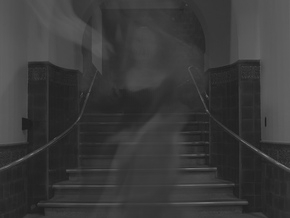
Many of the beautiful old buildings in Perth date back into the early 1800s. Some of these historic, old, buildings, have changed hands many times over the years, like Perth Museum. It was first build as a home for a distinguished citizen, Senator Roderick Matheson.
Roderick Matheson’s home was one of the largest and finest in Perth. Being a Senator, he often held lavish parties in the beautiful gardens to the side and rear of the stately home.
The magnificent garden was lush and green, with apple and plum trees, gooseberries and currants, peonies, bachelor buttons, and row upon row of breathtaking, richly-scented rose-bushes.
The garden was an impressive backdrop, where he entertained the area politicians, the wealthy, and prominent business owners.
His seven daughters – Mary, Rose, Flora, Isabella, Joan, Anna, and Eliza – each one strikingly beautiful in her own way, milled about the garden at the Senator’s parties, greeting guests, and giving them personal tours of the impressive grounds.
Some local say that the daughters were so attached to these gardens, and this impressive limestone home, that their spirits lingered, long after they departed this earth, and may still be seen at dusk, tending the roses, strolling in the moonlight…..

Some may not realize that the Matheson family occupied the impressive stone manor as their family home for almost a century.
Birkacre Tea RoomWhen the last family member, Eliza Matheson died in the house in 1929, the building was sold, and became the elegant Birkacre Tea Room from 1930-38, operated by William and Jessie Kinloch. Soups, sandwiches and afternoon tea were their specialties, served in the beautiful garden, during the fine weather months.


From 1938-46 the building was called The Vanity Fair, a posh restaurant owned by Clifford and Alice Carr.
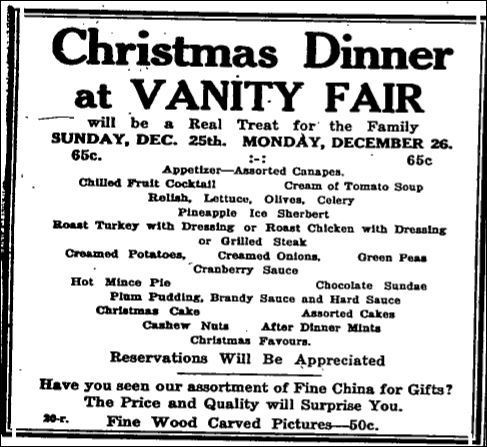
It was said that during the late 1930s and early 1940s members of the spirit world became particularly active in both the main building, as well as the gardens, as the owners played hosts to several prominent clairvoyants, at the Vanity Fair. Psychic Medium Madame Cornel was a regular guest during 1938. Madame Cornel was said to be a gifted medium, and people from the area flocked to the Vanity Fair to hear her psychic predictions.
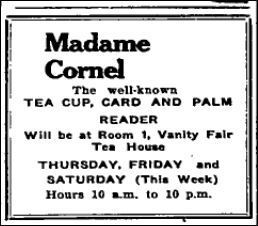

In 1939, the Vanity Fair played host to another well-known Clairvoyant from Ireland – Madame Kildare. It has been said that when Diana Kildare sat at the table and laid out her 40-year old tarot cards that you could hear a pin drop in the room.
“Unexplained Noises and Lights Along Gore Street!”There were many mysterious noises and lights seen both in the home, and in the garden, thought to be spirits brought back by the visiting psychics and mediums.
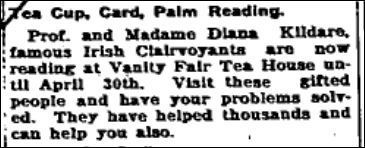
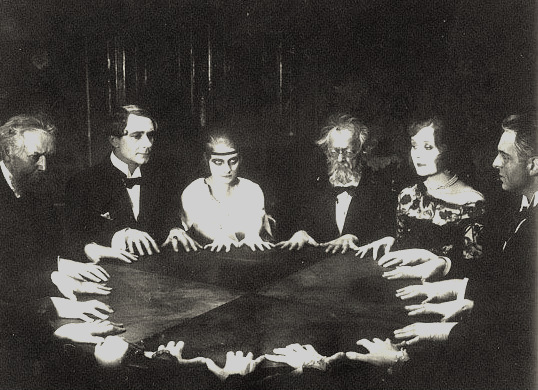
The Matheson family, particularly the beautiful daughters, didn’t seem to want to leave their home…..
Of the seven daughters in the family, only one married; and the other six girls remained at home, lavishing much time and energy tending the lush garden at the back of the property.
“I’ll Never Leave!”Although some paranormal researchers say that violence or sorrow may cause a spirit to feel bound to the world, until justice is rendered, this is not always the case.
Some say it can be the strong attachment to a particular location, and that spirits may return to a place where they spent their happiest times. It’s been said that these feelings of contentment, of the person never wanting to leave, can seep into a place, either in the walls of a building, or the soil of the ground itself, and leave a certain ghostly energy or impression.
Researchers claim that ghosts tend to stay in places that they considered to be their own during their former lives, and areas that were once very closely linked to themselves as a living human being.
photo: Matheson House and rear garden (now the Perth Museum)The Matheson House family garden– For many decades, many have reported seeing shadowy figures at dusk, tending the plants and flowers.
Former employees have shared their eerie experiences over the years.
………………..
The Perth-Upon-Tay Legion bought the building in 1947, and it was their meeting place until 1967, when it became the Perth Museum.
……………….
Today, Matheson House is home to the Perth Museum, located at 11 Gore Street East in Perth.

A view of the formal Dining Room of Matheson House, restored to its former glory as a stately family home.
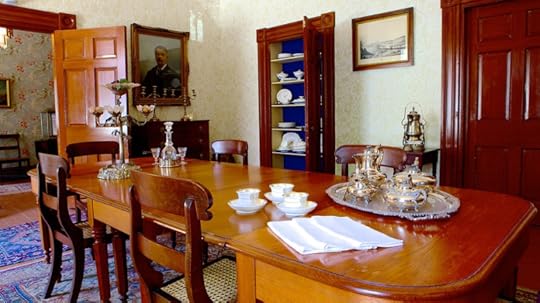
Matheson House Drawing Room – beautifully restored, one of the many opulent rooms at the Perth Museum
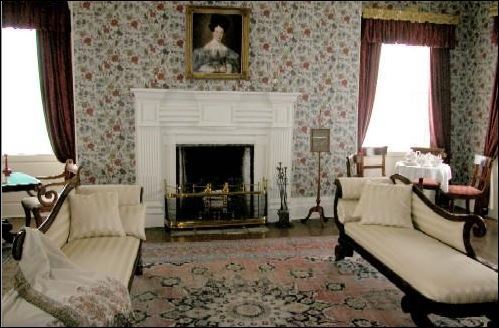
On your next visit to Perth, Ontario, step back in time at the Perth Museum, where you will see lovingly-restored rooms, as they were during the years when the prominent Matheson family occupied the home.

Remember to stop by the garden, where the lovely young Matheson daughters carefully tended their plants and flowers, and entertained prominent guests.
…………….
Don’t be surprised if you sense something unusual as you tour the old building. You may feel a draft, or see a flash of light, or movement.
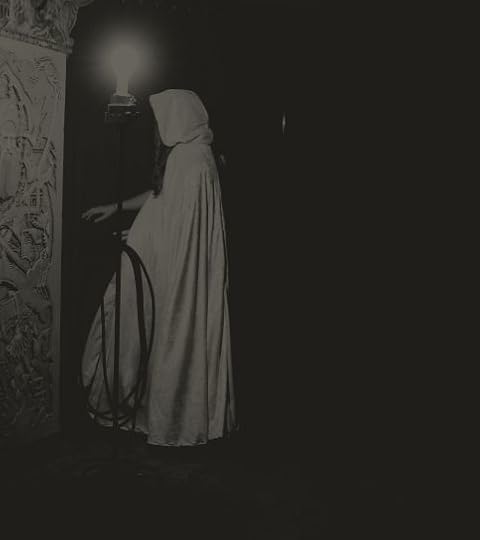
You may even feel as though someone is watching you!
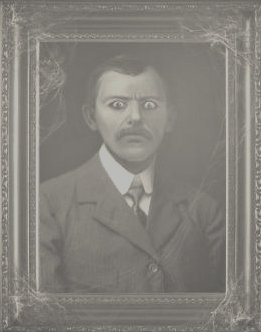
…………….
…………….
For more information on the Perth Museum (former home of the Matheson Family)…………….
Tel: 613-267-194711 Gore Street East, Perth, ON, K7H 1H9……………………………………………………………………………………………………………………………………………………..

……………………………….
Read about an eerie encounter with the spirit world that took place in the 1960s. What happened on October 24th, 1967 when a young girl wandered into the garden at Matheson House? Who did she encounter? What happened next?
Discover who or what was lurking, in the haunted garden at Matheson House in:
‘Lanark County Connections – Memories Among the Maples’. ISBN 978-0-9877026-47…………………………………

Arlene Stafford-Wilson
October 10, 2022
Herron’s Mills – Ghost Town
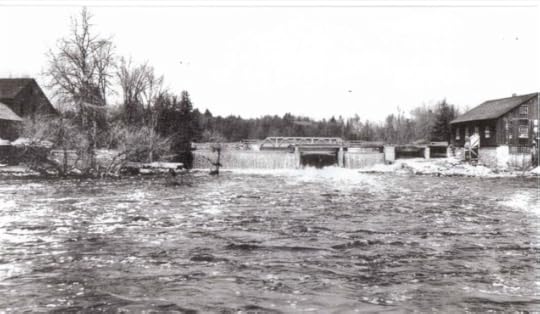
Herron’s Mills
These days, Herron’s Mills is a ghost town, but it was once a thriving community, built along the Clyde River in the Lanark Highlands, Lanark County. You can visit the area by traveling on Highway 511.
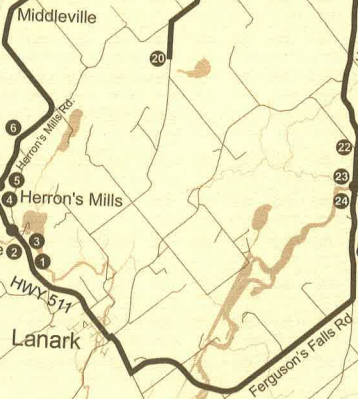 (from the Lanark Township tour)
(from the Lanark Township tour)The hamlet was originally called Gillies Mills, named for founder, John Gillies, who arrived from Greenock, Scotland in 1821, aboard the ship, ‘David of London’, with his parents, James, and Helen, and four siblings. John was an enterprising young man and by 1861 he and his wife, Mary, built a lovely home, and he established a saw mill along the banks of the Clyde River. Local legends say John Gillies traveled from Brockville, back to his home with a 90 pound saw on his back.

John Gillies, 1870

John Gillies’ house
Within a few years much of the area pine trees had been cut and Gillies was bringing in logs from other areas to his mill. He decided that it would be easier to purchase an existing mill in Carleton Place, and so he put the mill and his house up for sale.
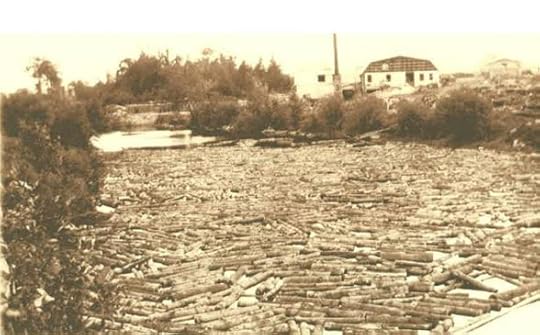
Logs in the Clyde River
Name Changed to Herron’s Mills
Gillies sold his mill in 1871 to James and John Herron who purchased the surrounding 104 acres of land as well as the mill. They re-named the mill – J & J Herron Company and the area became known as Herron’s Mills. One of the things the Herron brothers added to the operation was a stone bake-house. This was used to bake un-hulled oats or un-shelled peas. These were ground and used in oatmeal and pea ‘brose’, a popular dish at that time, brought by the settlers from Scotland.
Peas Brose, or Peas Porridge was often made in large batches and kept on the stove, as a quick and hearty meal for the mill hands coming home for lunch, or for the little ones arriving after their day at school. It was common to add a bit of water to the mixture to keep it in a paste consistency, as it would often harden from sitting on the stove top. There was a nursery rhyme at the time, its origins unknown, but thought to have become popular in the days when the pot of peas porridge was a daily sight in the settler’s kitchens:
“Pease porridge hot
Pease porridge cold
Pease porridge in the pot
Nine days old
Some like it hot
Some like it cold
Some like it in the pot
Nine days old”
Peas Porridge

Peas Brose
(Peas Porridge)
Ingredients
2 ½ cups green dried split peas, soaked overnight
3 Tablespoons butter
Salt and pepper to taste
Preparation
Soak the peas for 8-12 hours in a large bowl of water
Drain and rinse the soaked peas. Then add to a saucepan of water
Cover and bring to a boil
Simmer for one hour (may be longer) until the peas are tender
Strain the peas and add the butter, salt and pepper
Serve with ham or bacon if desired (the traditional style)
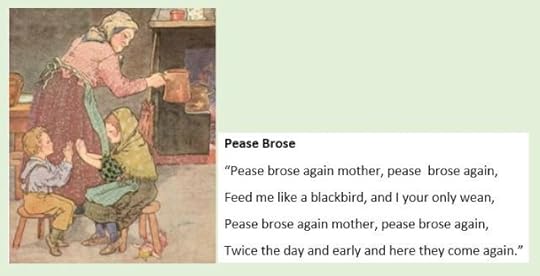
A Busy Village
Herron’s Mills thrived, and barns and stables were built as homes for the workers. A school was constructed, and teachers were given board with local families as part of their compensation.
James Herron opened a post office in 1891, located in their home. The Herron Mills post office was in operation until 1915.
In the busiest days of the community, Herron’s Mill was producing over 8000 feet of lumber per day.
The brothers John and James Herron dissolved their partnership in 1919, and in 1920, James passed away.

.
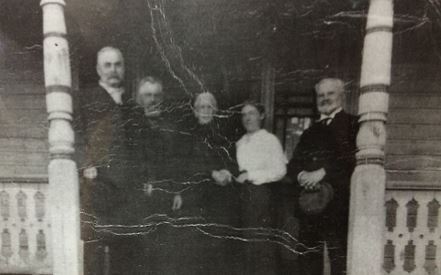
Herron Family Home, (was Gillies’ home), photo: 1915, L to R – John Ackland, James Herron,
his wife, Janet (Malloch) Herron, their daughter, Mary Herron, and Robert Ackland
Ghost Town
After James’ death, ownership of the mill was passed down to his son, Alexander.
When Alexander passed away in 1946, his sister Mary ran the mill for five more years.
By 1951 the mill was closed, the workers moved away, and the small community of Herron’s Mills was destined to become a ghost town.
There are few signs remaining of this once thriving village, other than some abandoned structures, and the old damn which can be seen from the road.
On a Sunday drive past this pioneer community we might imagine those busy bustling days, the sounds of the mill, the children playing, and the mothers stirring their peas porridge pot, on an old wood stove.
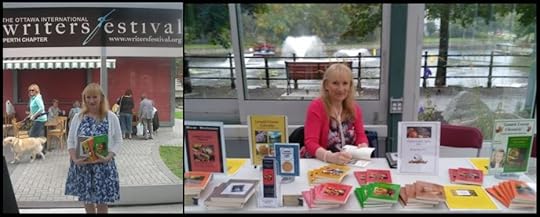
Arlene Stafford-Wilson
Member, Association of Professional Genealogists
Member, Lanark County Genealogical Society
Author of 10 books: “Lanark County Christmas”, “Lanark County Comfort”, “Lanark County Collection”, “Lanark County Calling”, “Lanark County Classics”, “Lanark County Connections”, “Lanark County Calendar”, “Lanark County Chronicle”, “Lanark County Kid”, & “Recipes & Recollections”
available at local stores or email: lanarkcountybooks@gmail.com
October 9, 2022
Thanksgiving at the Stafford House
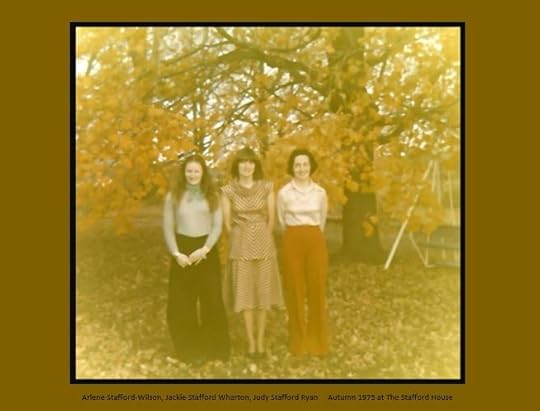
Thanksgiving
at the Stafford House
Everyone came home…..if they could. By the mid-1970s Tim and Roger were both in the O.P.P., which meant they weren’t always able to be there for family holidays. Judy and Jackie were busy with their careers, and I was at the Perth High School, trying to figure out what I’d do when the time came for me to try my luck in the world.
The setting was postcard-perfect. A big red brick farmhouse, with enormous maple trees displaying their kaleidoscope of fall colours. At the back of the house a dozen McIntosh apple trees stood, branches hanging low, loaded with ripe red fruit. By October it was warm in the daytime, and cool enough at night for local farmers to fire up their wood stoves. The rich scent of wood smoke drifted across the fields and was the perfect fall incense.
As we gathered together, the old house was filled once again with our pockets of conversation in the kitchen and living room. Dad and the boys were always talking about cars, and Mother discussed her menu with us, assigning our jobs – “fill up the pickle dish”, “pour the tomato juice into the small glasses”, “fold the napkins….diagonally across”.
In the evening after the meal there were games – sometimes cards, or maybe Monopoly. There were jokes and laughter, and unguarded conversations sprinkled with the news of the day, and our hopes for the future.
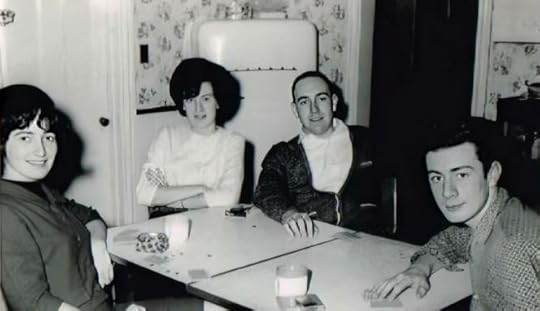
left to right – Judy Stafford, Jackie Stafford, Tim Stafford, & Roger Stafford (the kitchen at Stafford House)
Mother’s homemade stuffing was a holiday favourite. (recipe below) This old family recipe was her mother’s. Granny Rutherford’s father owned a butcher shop – the Canterbury Meat Company, in Huddersfield, England, and savory ground sausage meat was the key ingredient to their traditional stuffing, along with dried bread crumbs and seasonings.
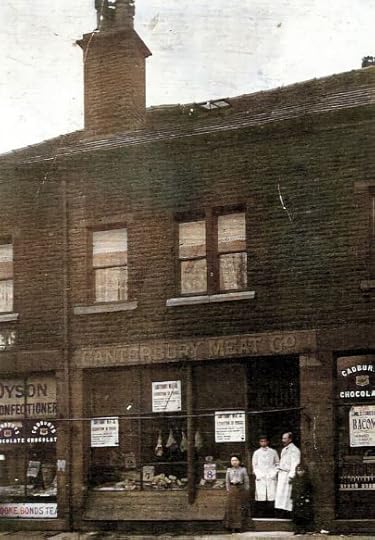
Canterbury Meat Company, 15 Market Street, Huddersfield, England, 1906

Traditional Sausage Dressing
There were lots of Thanksgiving favourites – the homemade pumpkin pie baked in Mother’s light, flaky pastry, the farm-fresh buttery mashed potatoes drizzled with velvety seasoned gravy, smooth buttered turnip, and light homemade rolls, fresh from the oven.

There would be many decades of Thanksgivings at the Stafford House on the 3rd Line of Bathurst. The setting was always the same – the sturdy welcoming red brick house, a spectacular backdrop of maple leaves in orange, red and yellow, as far as the eye could see. The sounds were always the same – the pots and pans clanging and clattering in the kitchen, Dad’s soft melodic voice sharing a joke or story with the boys, and the girls talking about the latest fashions, or a dreamy new movie star. The unforgettable scents of autumn were the same outside – the dried leaves on the ground, and the sweet McIntosh apples hanging low on the trees behind the house. Inside the scent of turkey filled the air for hours, along with the aroma of the sausage meat, and the homemade rolls baking in the oven.
Those special Thanksgivings still live in our hearts and in our minds – the times when we were all together, back in the old house, enjoying a special meal made with love for all to share, the warm smiles and the laughter, walking through the yard, under the colourful sprawling maples. We were home again.
….

Stafford House
Granny Rutherford’s
Sausage Dressing:
1 lb of sausage meat
2 eggs
1 cup hot milk
7 cups bread crumbs
1 c chopped celery
2 Tbsp chopped onions
1 Tsp salt
4 Tbsp parsley
1/2 tsp of poultry seasoning
Method: Fry meat until brown, drain off fat, add the eggs, hot milk, and the rest of the ingredients
Mother stuffed the turkey cavity, and any extra stuffing was wrapped in aluminum foil and baked in the oven.
Enjoy!

Granny Rutherford’s sausage dressing recipe from: “Recipes & Recollections: Treats and Tales from Our Mother’s Kitchen” ISBN 978-0-9877026-09, page 49.
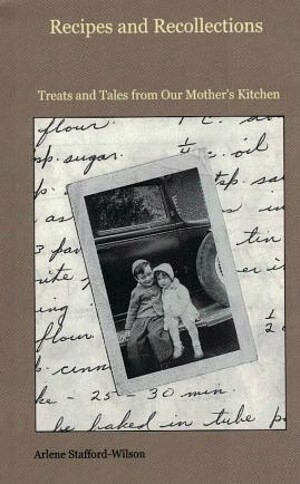
(kids featured on the cover of the book: Tim Stafford and Judy Stafford, photo taken in 1947)

Arlene Stafford-Wilson
Member, Association of Professional Genealogists
Member, Lanark County Genealogical Society
Author of 10 books: “Lanark County Christmas”, “Lanark County Comfort”, “Lanark County Collection”, “Lanark County Calling”, “Lanark County Classics”, “Lanark County Connections”, “Lanark County Calendar”, “Lanark County Chronicle”, “Lanark County Kid”, & “Recipes & Recollections”
available at local stores or email: lanarkcountybooks@gmail.com

